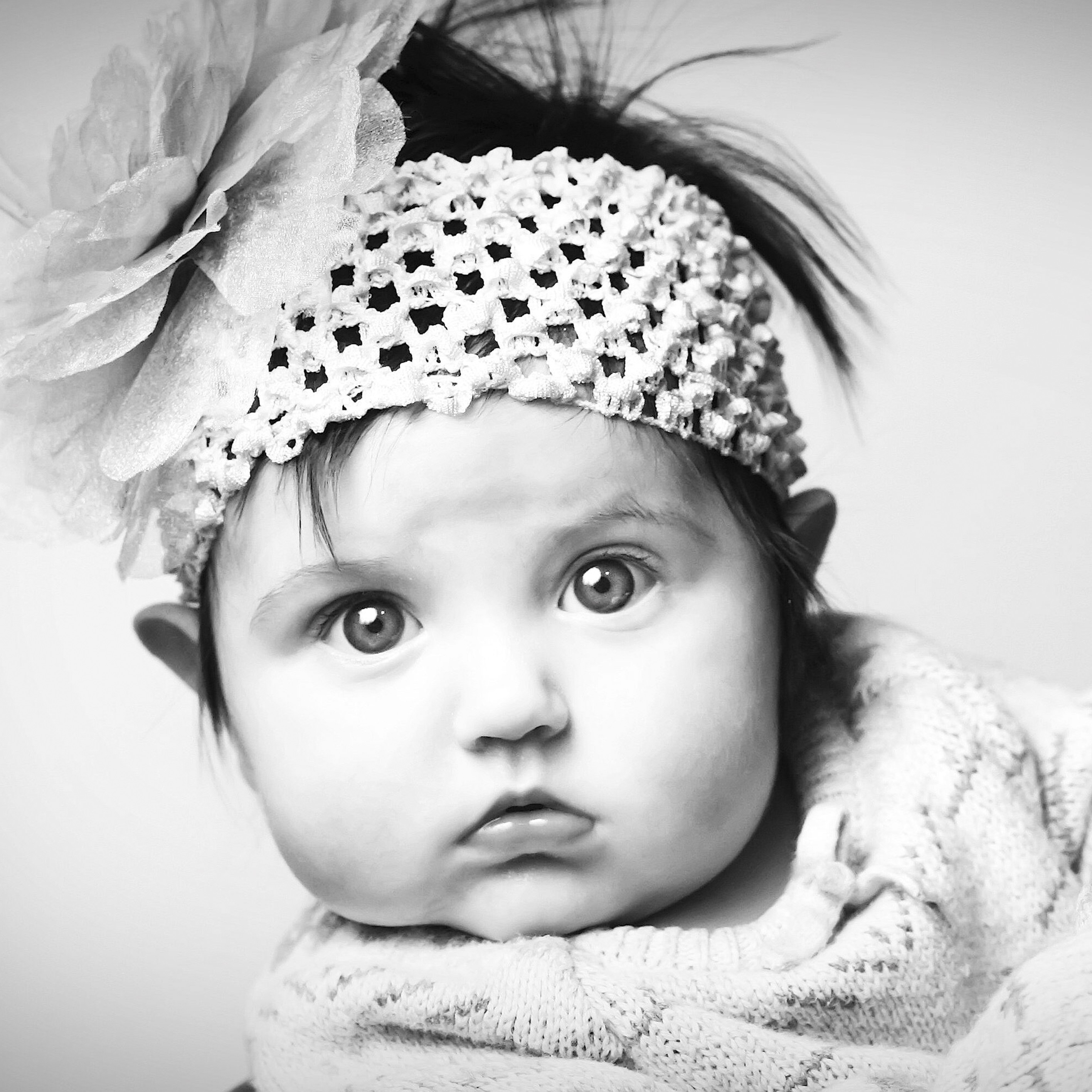Chapter 8: Ages, Stages, and Groups
Newborns
Babies
Toddlers
Preschoolers
School-age Children
Tweens and Teens
Grouping Families
Although it can be helpful to speak of children in terms of ages and stages, it is vital to keep in mind that every child is unique and individual. Your intuition is your best guide as to how to handle different ages and stages. Paying attention to the child’s unique presence teaches you a great deal about how you might react and connect with him, in order to capture more of his true personality in a photograph.
If you are a parent, you will likely want to document your child’s life to preserve your own memories of his or her birth and childhood. By capturing these photos you are literally illustrating a life story. How many times has a son or daughter asked, “What was I like when I was little?” Posed portraits from a photo studio or a school yearbook never tell the whole story. It’s the pictures of children laughing or sleeping as babies, skiing down a hill for the first time, running in circles, reading quietly as a teenager, or a million other images that record a history of childhood that tell the real story. This chapter is a guide to each developmental stage of a child’s life, addressing the challenges and rewards of photographing each stage with tips to help you along the way. The ideas covered in this chapter are meant to serve as guidelines developed from experience, rather than hard-and-fast rules. Your own experience with children is your best advisor.
Newborns
Photographing newborns is not for the faint of heart. It takes a great deal of patience, but it is rewarding for many reasons. Who can deny the miracle of a newborn baby? Perhaps at no other time in a child’s life do stunning changes take place on almost an hourly basis. This stage of development is endlessly fascinating to the parents as they watch each captivating gesture and expression to figure out what part of their baby looks like Mom or Dad.
To capture a photo of a newborn looking like a newborn (wrinkly skin, furry ears, and all), try to photograph the baby in the first couple of weeks of life. At this stage the babies are still very flexible and can be “folded” over into the fetal position and, for example, easily placed into Mom’s hands, as in 8-1. In many instances, very young babies haven’t yet developed the baby acne so their skin is more clear, which results in less retouching after the photo session.
For optimum results when photographing a newborn, keep the room a bit warmer than usual. This keeps the baby comfortable even when undressed for the naked-baby shots.
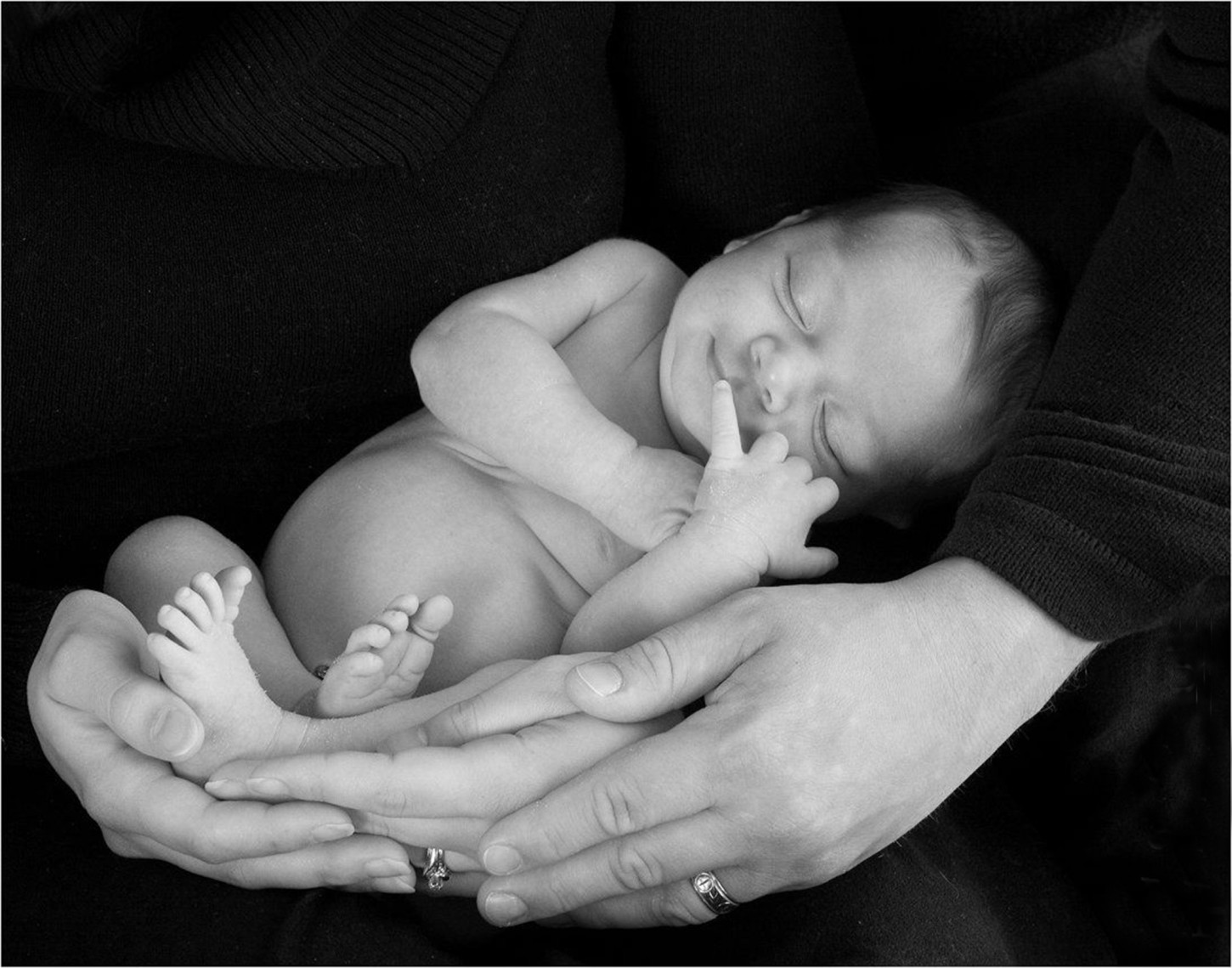
8-1
ABOUT THIS PHOTO The sleeping and smiling baby is folded and placed into the mother’s hands. This can only be done with a very new newborn. Taken at ISO 1600, f/4.0, and 1/400 second. ©Theresa Smerud / www.theresasmerud.com
Challenges
Newborns seem to arrive prewired to sense tension in a room. If mom is stressed about the photo shoot and tension is high, most often the baby can sense it and becomes very fussy. Calm moms make for calm babies so spend a minute soothing the mother’s concerns about the photo session. Let her know that she can stop and comfort or feed the baby at any time.
Newborn’s sessions are almost always a hurry-up-and-wait proposition. The baby nods off for half a second and you make a few photographs before the baby’s eyes open and he or she starts to scream. You might be surprised to know that many of the seemingly serene infants in these photos were hysterical mere moments before their photograph was taken. Go ahead and take a few photographs of the crying, fussy, or yawning baby, as in 8-2; this is certainly a big part of a developing infant.
Because newborns are often reddish or slightly jaundiced, it can be more flattering to convert the images to black and white for a more timeless look.
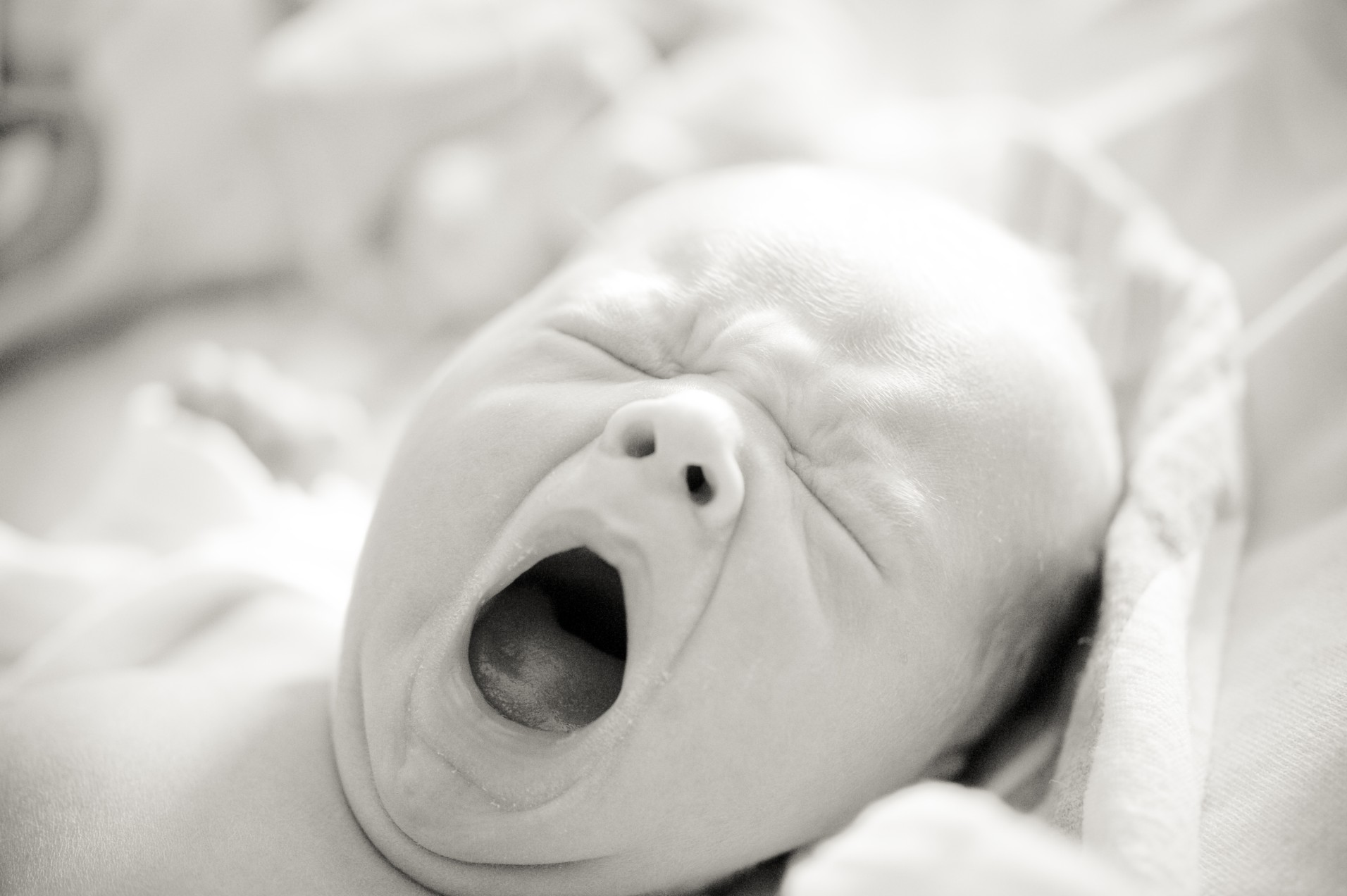
8-2
ABOUT THIS PHOTO Great big, expressive yawns from a tiny newborn are great fun to capture spontaneously. Taken at ISO 800, f/2.8, and 1/60 second. ©Zofia Waig / www.zofiaphoto.com
“There is only one pretty child in the world, and every mother has it.” ~Chinese proverb
Don’t photograph a naked baby on any surface that isn’t washable. Backgrounds, furniture, parents, and photographers can and will be wet on or drooled upon by the little bundle of joy, so plan accordingly. You may want to have on hand a stash of inexpensive solid color (white is always great) blankets to wrap or lay the baby on.
Very young newborns have not developed the ability to focus their eyes yet, so it is easy to get an image of a very cross-eyed baby. If a baby is getting the cross-eyed look, you may want to turn the baby’s head into a different position or just wait a minute for a more pleasing expression.
“A baby is God’s opinion that the world should go on.” ~Carl Sandburg
Rewards
The soft cheeks, wrinkly skin, and tightly curled fists of a newborn are unmistakable. Capturing this stage is well worth the effort, and there are many photographers who specialize in newborn photography. Newborns can’t talk back or run away. They are so flexible you can curl them up and let them sleep while you shoot away. Take the time to get the baby to sleep. Ask the mother to feed the baby just before she comes to the photo session so the baby arrives full and ready to nap. Wrapping an infant snugly in a blanket so that the arms and legs are tight against the body (also called swaddling) is an almost-guaranteed sleeping pill for infants. There are many resources on the Internet for handmade designs, such as Natalija Brunner’s creations (www.daidalorange.com).
Rock the tightly swaddled baby until he or she is fast asleep (this usually takes about 15 minutes, so you have to be patient). When the infant is finally sleeping, you can move around freely, placing props, blankets, and even the baby, or babies, in just the right places, as in 8-3.There is nothing more universally appealing than the sight of a sleeping baby.
Newborns tend to be very floppy, so use the parents as a prop to hold the baby in their arms or even lay the baby over their shoulders, as shown in 8-4. This type of posing offers great opportunities for photographers and parents to come up with very unique, creative, and touching images.

8-3
ABOUT THIS PHOTO Newborn twins swaddled in hand-crocheted pods in a basket make a delightful portrait for posterity. Taken at ISO 200, f/2.8, and 1/200 second. ©Sara Kovacs / www.babybeanportraits.com
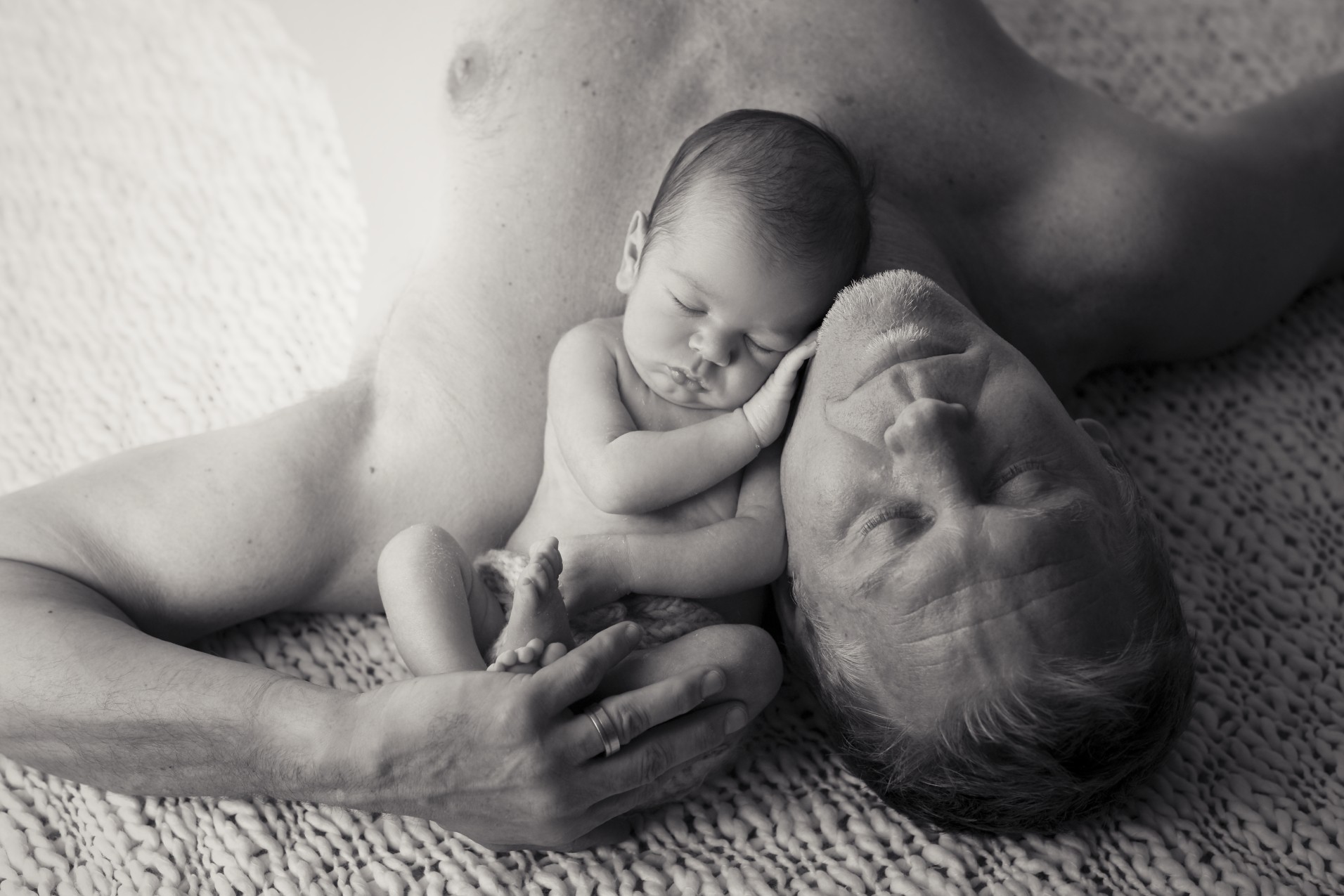
8-4
ABOUT THIS PHOTO This very tender and beautiful portrait of a father supporting his newborn child was made by placing the baby by his shoulder after sleep set in. Taken at ISO 200, f/3.5, and 1/500 second. ©Sara Kovacs / www.babybeanportraits.com
Babies
The first year of life presents one milestone after another. As babies grow older and can recognize and respond to people around them, their range of expressions and gestures increases, giving the children’s photographer much more to work with. Darling expressions can be evoked by the simplest click of your tongue or breath on their cheeks. It seems like their smiles come unwarranted at this point because they have learned that smiling pleases the people around them.
Three to six months
Before they are able to walk, you can photograph babies in the three-to-six month age range sitting in a chair, lying on the grass, or holding themselves up by a table or wall. At this time, the mother, a babysitter, or older sibling can be a great asset to you as an assistant, just to watch carefully and make sure that the baby is safe at all times. It is important that you are comfortable with your camera and its settings so you can spend your time fully focused on the baby and her expressions rather than fiddling with your camera.
“If a child is to keep his inborn sense of wonder, he needs the companionship of at least one adult who can share it, rediscovering with him the joy, excitement, and mystery of the world we live in.” ~Rachel Carson
Between three and four months, wonderful and unique expressions can be elicited by parents, so it pays off to always have a camera nearby. Be sure to get down to the baby’s level to seize the moment (see 8-5).
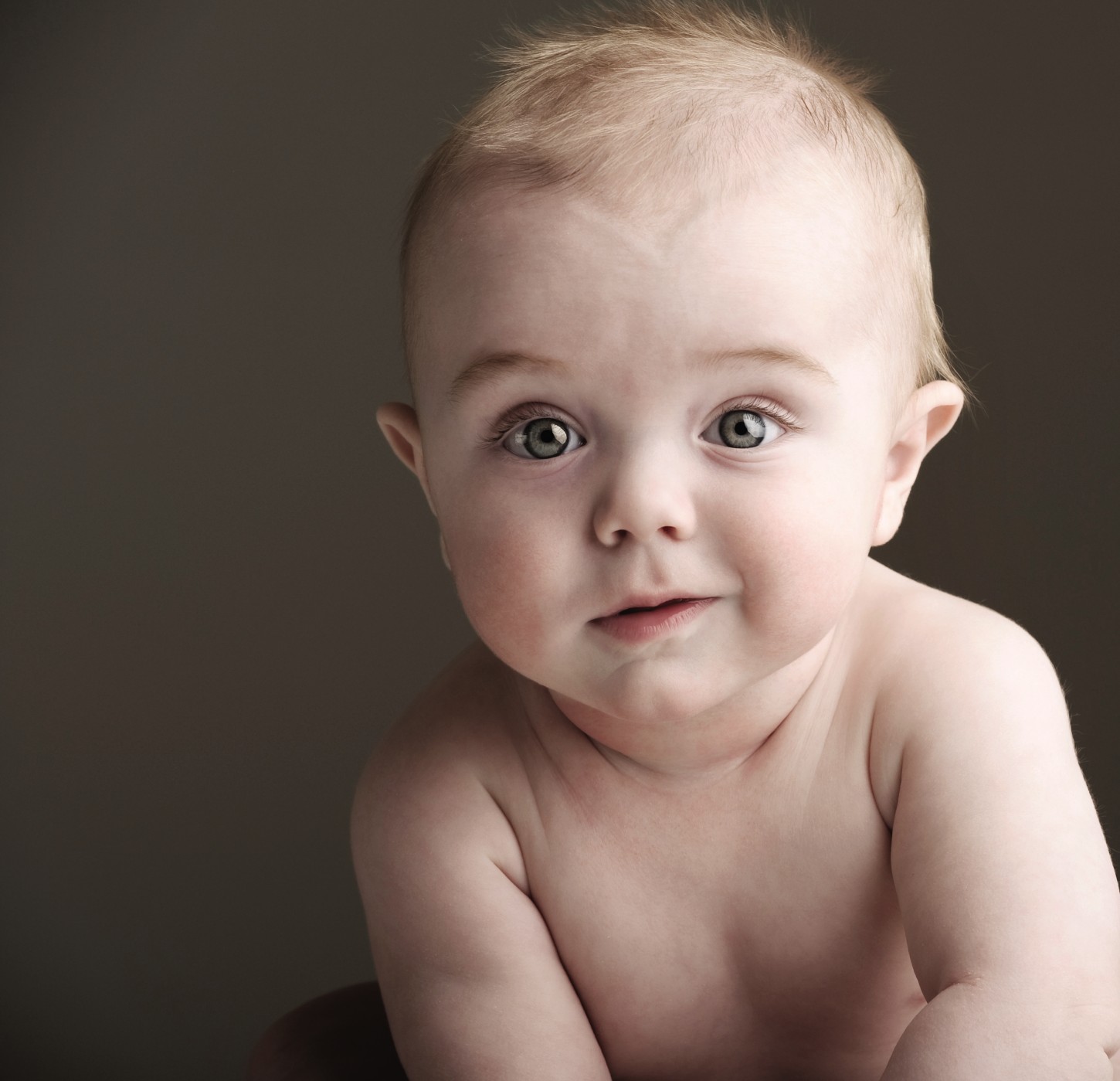
8-5
ABOUT THIS PHOTO Be ready to capture those unique and amusing expressions that babies come up with spontaneously. Taken at ISO 200, f/9.0, and 1/250 second. ©Allison Tyler Jones / www.atjphoto.com
Six to twelve months
Between six and nine months, a baby is usually able to sit up, but isn’t yet crawling — ideal for a photo opportunity. Babies often lean to one side or another like they are going to crawl, giving you ample opportunities for capturing their chubbiness. They imitate the faces you make at them and are able to hold on to a toy. Remember, everything goes into their mouth at this stage so be careful what you leave within their reach. Perch them on a table, a chair, or even in a favorite basket for a more creative twist on the typical baby portrait, as in 8-6.
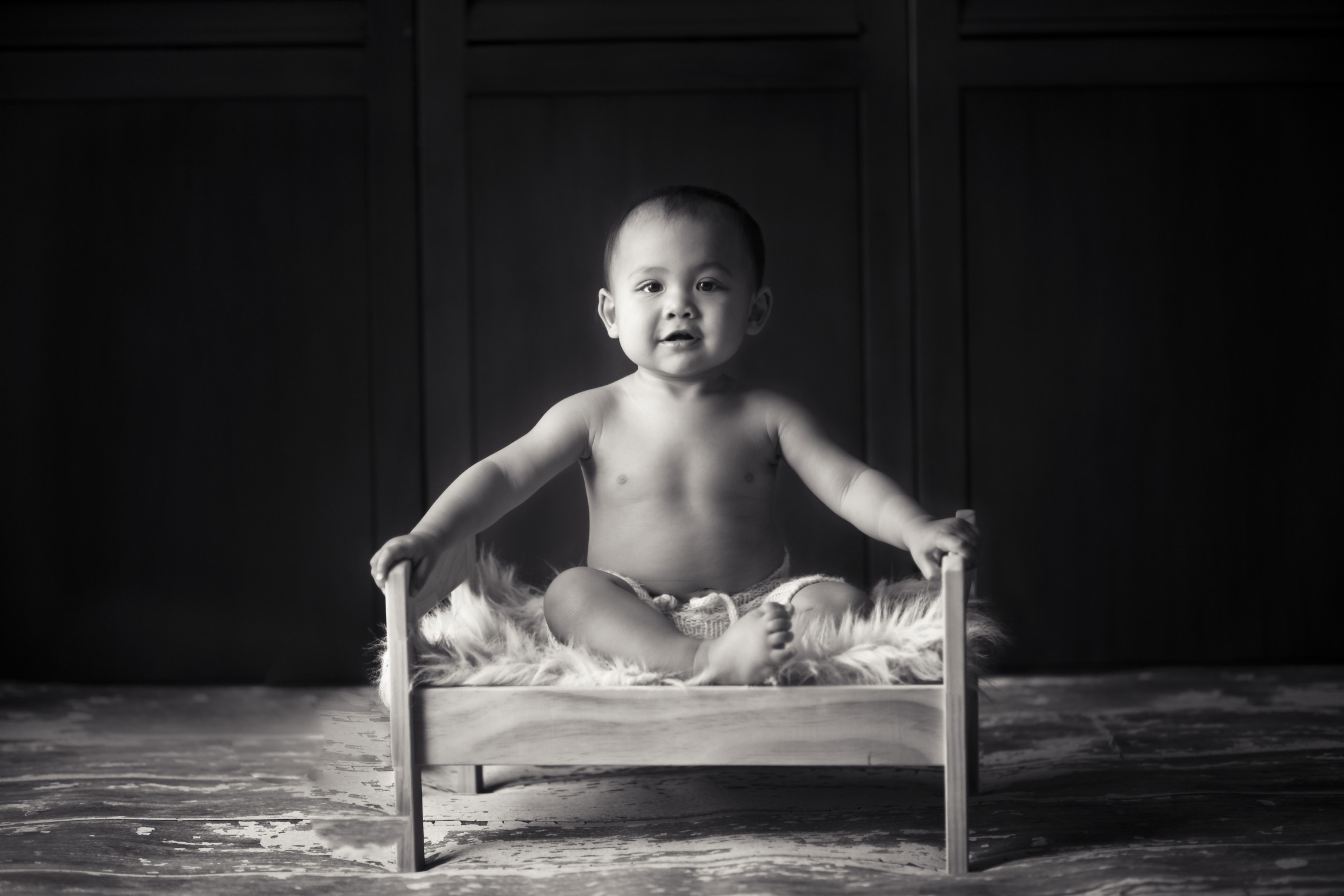
8-6
ABOUT THIS PHOTO This little boy holds such a profound presence and confidence for his age. The soft window light gives the portrait dimension and mood, while highlighting his soft skin. Taken at ISO 200, f/1.4, and 1/200 second. ©Sara Kovacs / www.babybeanportraits.com
Between nine and ten months, many babies begin crawling and might even be able to stand next to a chair while holding on. Make sure that any chair or prop you use to photograph a baby on is sturdy and won’t tip over onto them. If the baby isn’t steady, have Mom or an assistant stand just out of camera view to prevent any mishaps.
Most babies start walking at about the one-year mark, and this is a common milestone for parents to chronicle with a portrait. It is a perfect time to capture those first tentative steps when they walk, using their arms to give them balance, as in 8-7.

8-7
ABOUT THIS PHOTO A photographer and the grandmother of these two girls captured the wobbling youngsters as they exited the house. The lines of the doorway frames them well, and the silhouetting light separates them from the background. Taken at ISO 1250, f/9.0, and 1/200 second. ©Elizabeth Sanford / www.momentsbyliz.com
Toddlers
Toddlerhood is defined by activity and movement. Toddlers are usually very responsive to toys and to your words and expressions. These little ones need to be in an environment where they have freedom to move and explore in complete safety. Their walking skills usually progress quickly from being a little clumsy to ambling at the speed of lightning.
The latest generation of children has started to pose much earlier because parents and others constantly peer at them through cameras and cell phones, starting at the very moment of birth. This makes it a bit more challenging at times to elicit a natural expression, even from a toddler.
The toddler stage is characterized by a lot of growth and change, mood swings, and some negativity. Toddlers are long on will and short on skill. This is why they are often frustrated and misbehave.
“A three-year-old child is a being who gets almost as much fun out of a fifty-six dollar set of swings as it does out of finding a small green worm.” ~Bill Vaughan
When working with toddlers, assess whether an assistant or parent present is an asset or liability. The parent in 8-8 was an asset. This photo turned out beautifully because she was holding and interacting with her child, so that the baby felt secure and comfortable.
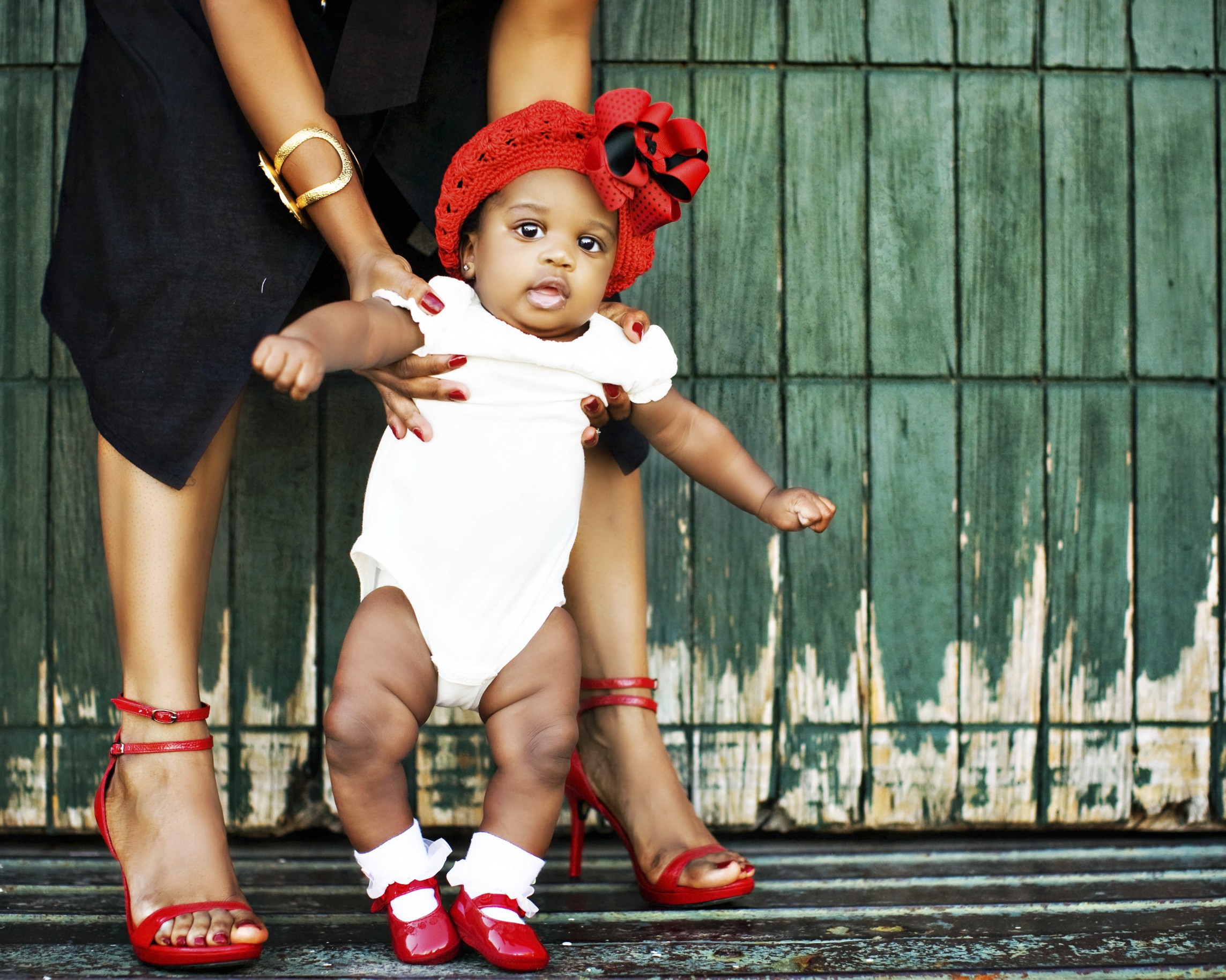
8-8
ABOUT THIS PHOTO Bright complementary colors and a contrast of uptown and rural make this photograph of a fashionable mother and child very contemporary. The mom’s arms and legs provide a very safe and dynamic frame for the baby. Taken at ISO 200, f/2.5, and 1/800 second. ©Melanie Johnson / www.melaniejohnsonphotography.com
A relaxed parent usually creates an atmosphere for a relaxed child, and the opposite is almost always true. If you have a parent who is overly coaching the child, you may want to kindly suggest that the child might perform better if she stepped back for a moment. This takes courage but is often worth it in the end.
“A mother understands what a child does not say.” ~Susan Sarandon
Activities such as peek-a-boo and blowing kisses are likely to induce charming reactions. Whistles, bells, and squeaky toys are likely get an expressive response. Some photographers like to make noises like dogs barking and cats meowing for a reaction. You might be better at pig noises or talking like Donald Duck.
Toddlers are distractible, so be armed with many entertaining and spontaneous diversions. Being a children’s photographer requires that you learn to be comfortable being silly and uninhibited.
Asking a child to stand near a strong vertical structure, as in 8-9, or propping a child on a door, as in 8-10, frames the child and provides a perch — someplace that is just off the ground that makes him or her hesitant to jump down and run around, allowing you a fleeting few seconds to get the shot. Other good perches are benches and tables. Always make sure there is an adult next to the child, just out of camera range, to catch the child if he or she should decide to make a jump for it.
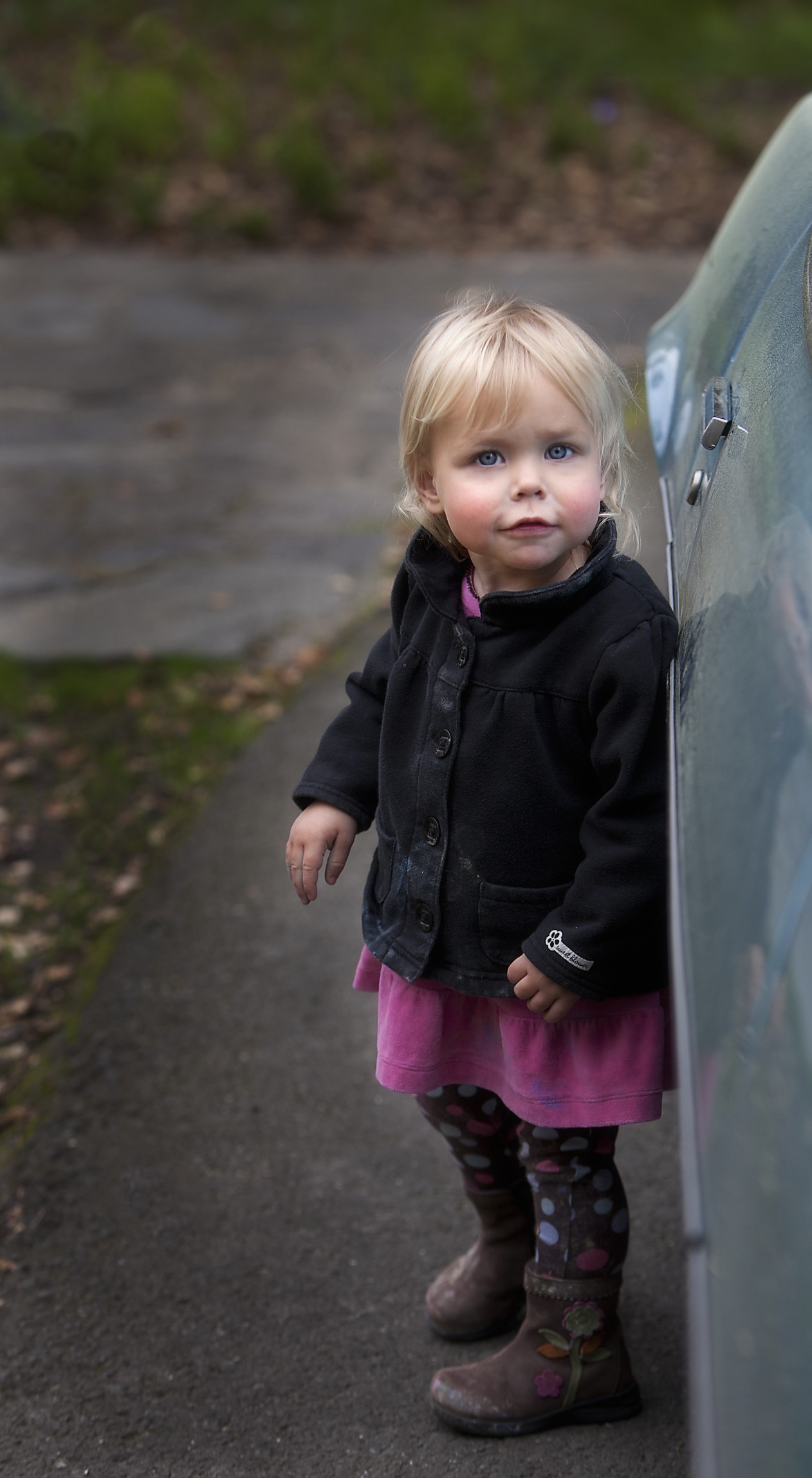
8-9
ABOUT THIS PHOTO The color and reflection on the car gave me a frame, and the car itself offered support when photographing this toddler dressed for a country excursion. Taken at ISO 200, f/3.5, and 1/320 second. ©Ginny Felch / www.photographingchildren.com
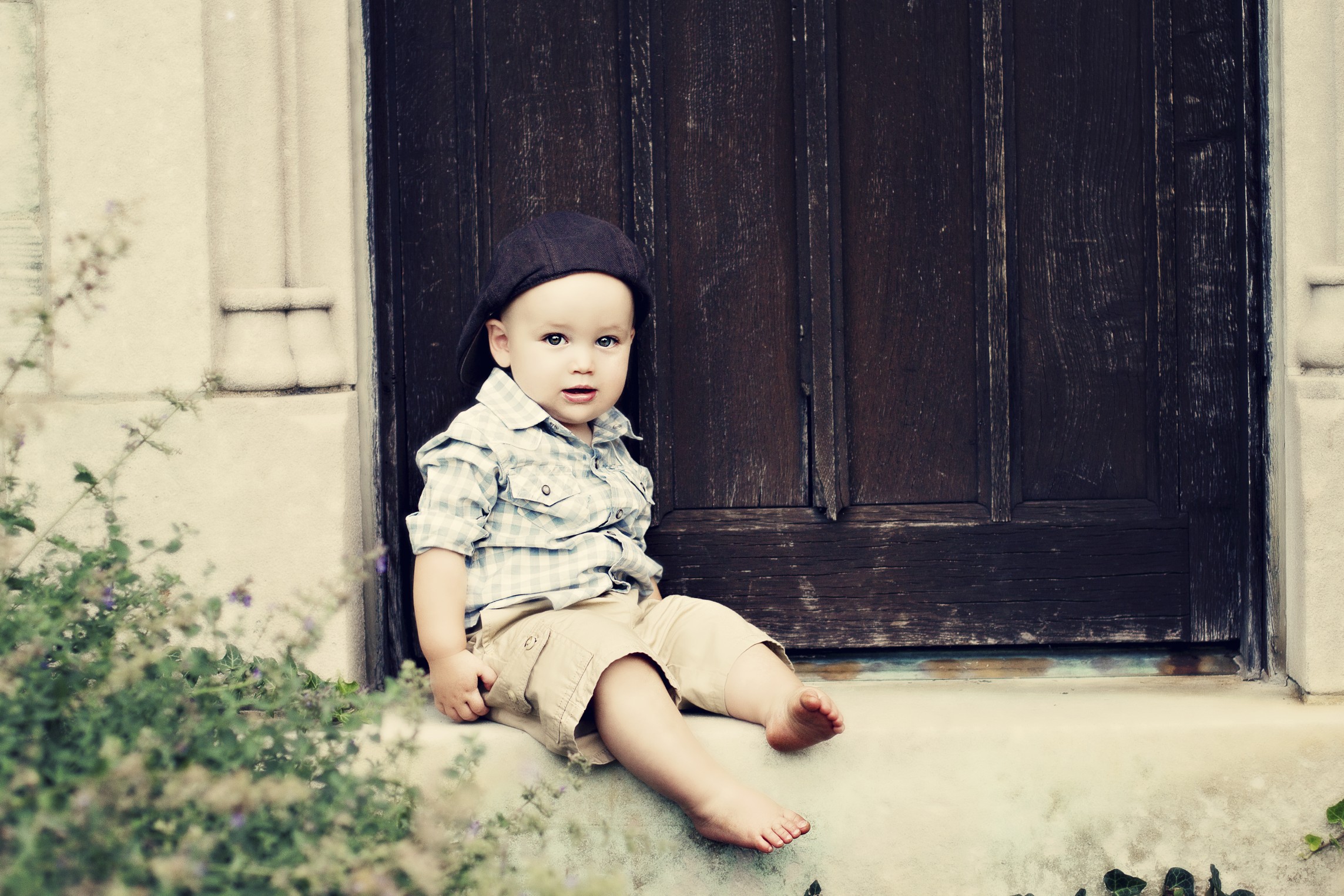
8-10
ABOUT THIS PHOTO The step served as a useful perch to add support and structure for the baby. The stone door frame also provided a dynamic background and L-composition to enhance the photograph. Taken at ISO 400, f/2.8, and 1/200 second. ©Jen Carver / www.jencarverphotography.com
Give toddlers something to become involved with while photographing them. The portraits in 8-11, 8-12, and 8-13 show different tactics taken with toddlers during a photography session. Props such as ledges, chairs, and beds work well if the toddler is willing and able to sit still. If not, offering them flowers or crayons or something to keep their hands busy can keep their attention for a few minutes. Of course, if you are a parent at home with your children, these things happen quite naturally, and then all you need to do is capture them!
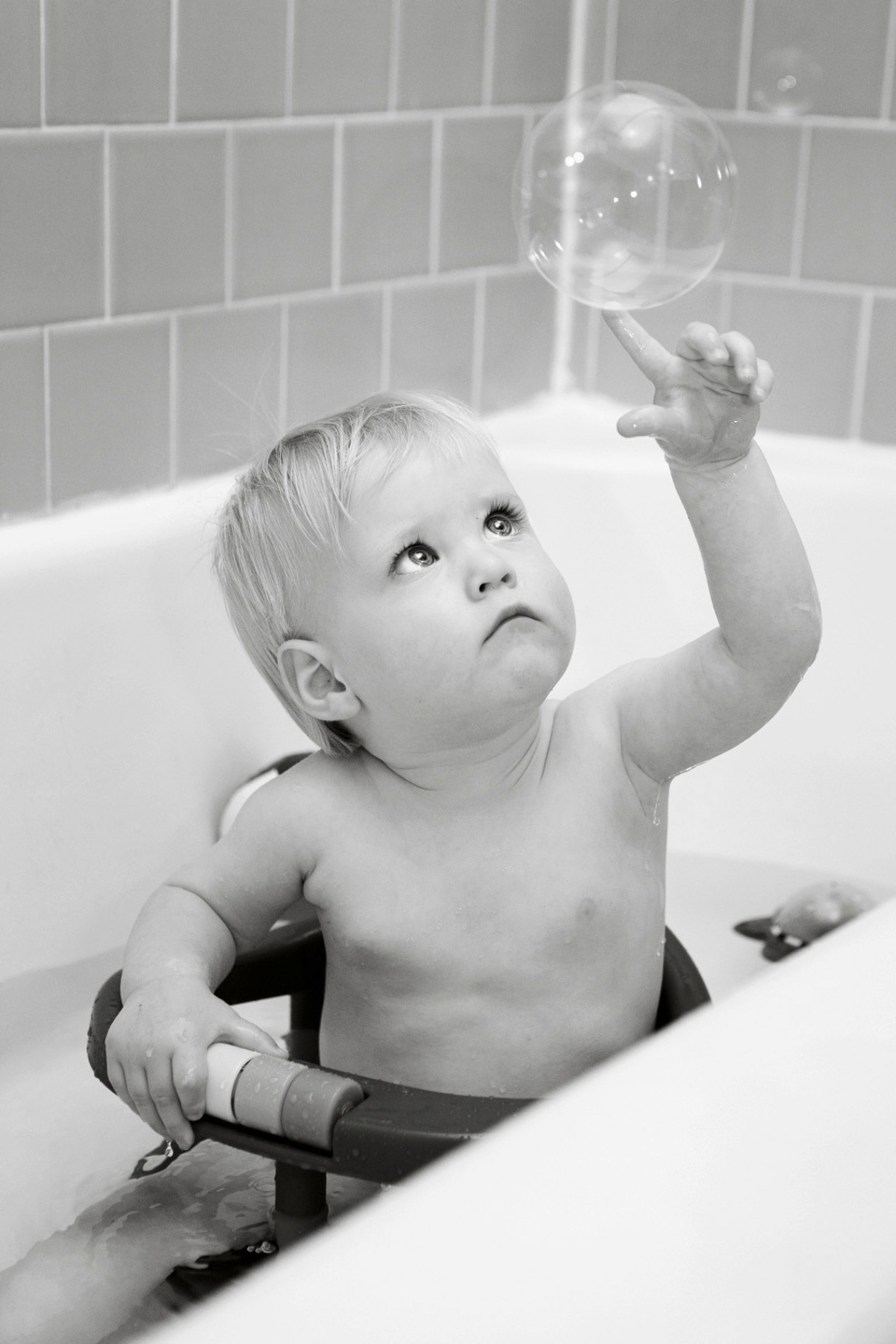
8-11
ABOUT THIS PHOTO The bathtub is often a place for fun and fancy, so this photographer took advantage of bubbles, a toddler’s favorite pastime. The gesture and expression are captured here with a simple background, emphasizing the baby and bubble. Taken at ISO 200, f/4.5, and 1/200 second. ©Wendi Hiller / www.wendihillerphotography.com
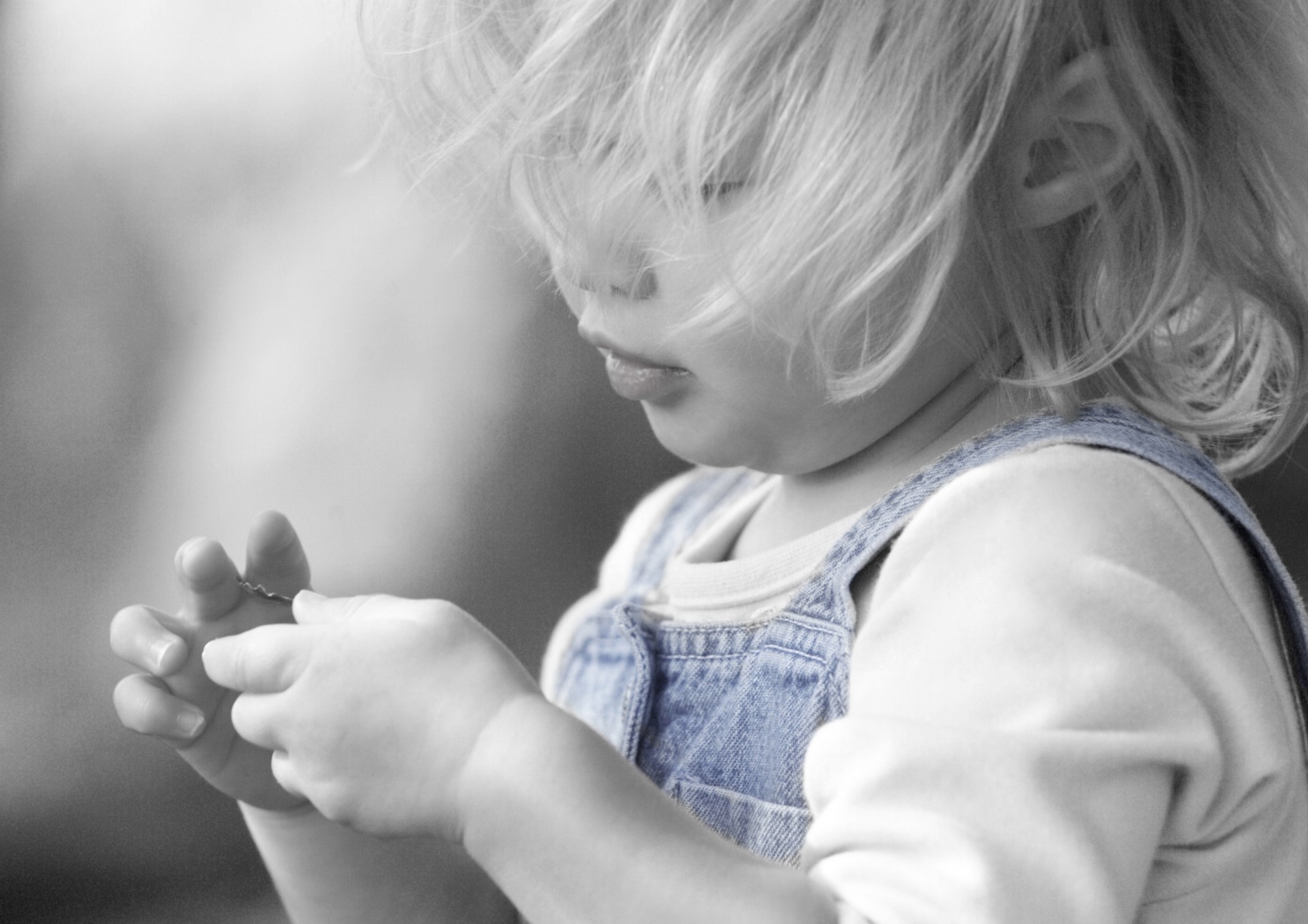
8-12
ABOUT THIS PHOTO A little girl’s preoccupation with a small flower offered the photographer a still moment with this toddler. The tussled hair and soft coloring add to the mood. Taken at ISO 200, f/2.8, and 1/125 second. ©Lori Nordstrom / www.nordstromphoto.com
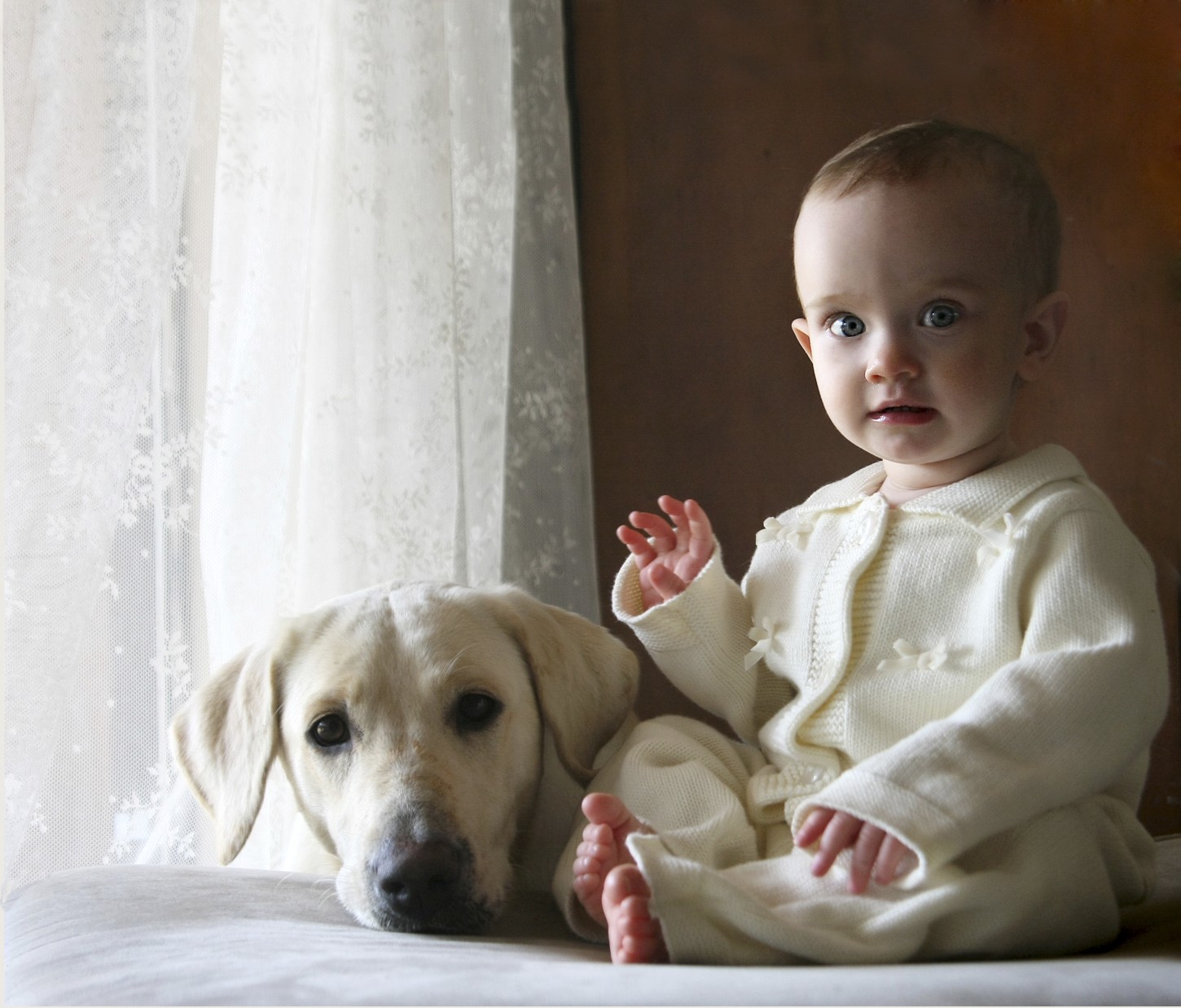
8-13
ABOUT THIS PHOTO Involving a friendly family pet offers humor and tenderness. The dog here seems to be intent on supporting the baby on the bed, while the photographer takes advantage of exquisite window light. Taken at ISO 500, f/3.5, and 1/125 second. ©Elizabeth Sanford / www.momentsbyliz.com
Preschoolers
Every child photographer has a favorite age. For many, preschoolers present the best of all worlds. Preschool children are communicative, responsive, spontaneous, playful, silly, talkative, and generally charming.
Many preschoolers are trusting, engaging, and fun to be with. Children who are three to about four-and-a-half years old stand out because they are still babies in all the best ways. They haven’t usually lost their chubby baby cheeks, as in 8-14, nor given up their unself-conscious and innocent expressions.
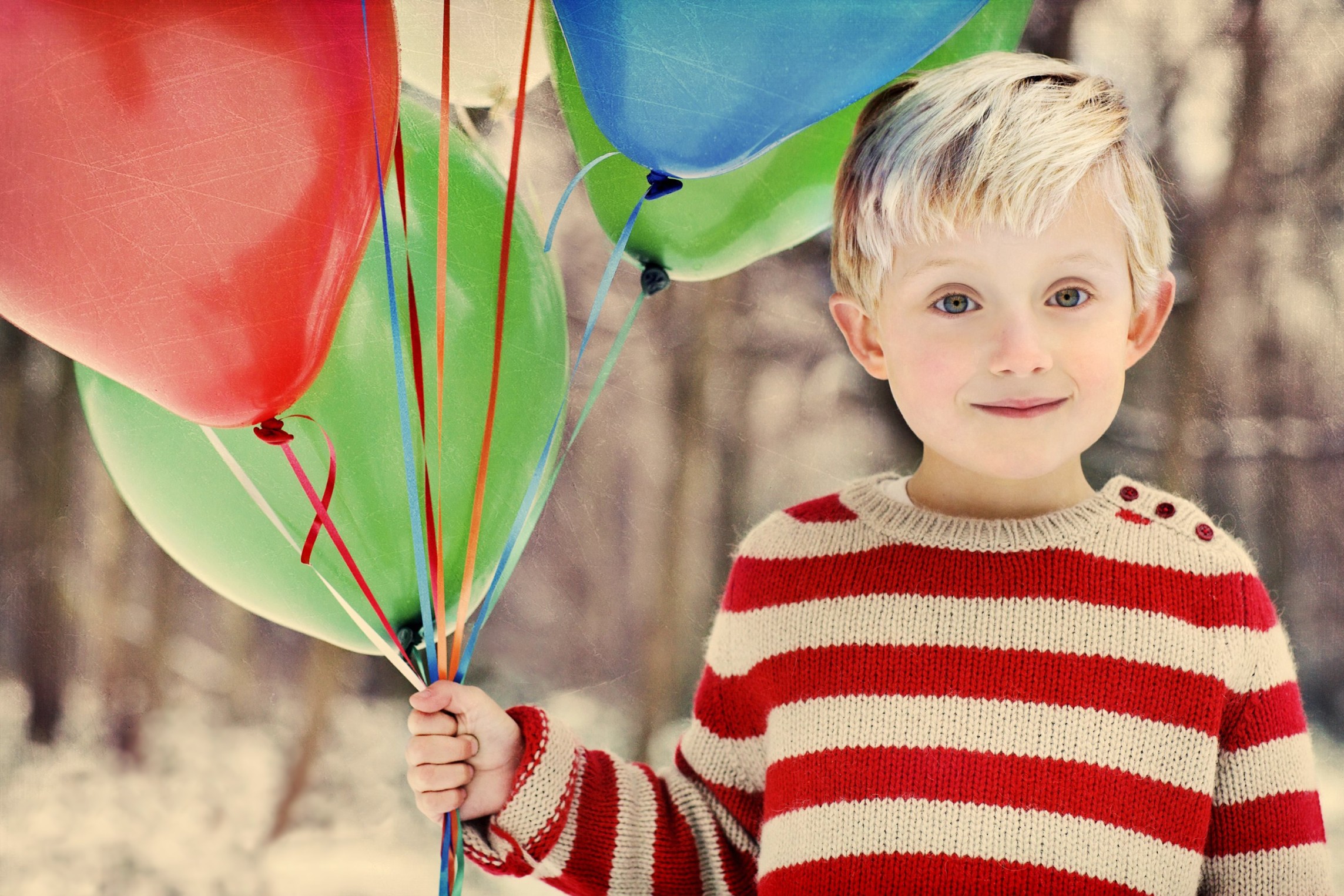
8-14
ABOUT THIS PHOTO This colorful image and wondrous expression was fueled by this boy’s possession of helium balloons. Taken at ISO 1000, f/4.0, and 1/1600 second. ©Abi Campbell / www.abicampbellphotography.com
You can entice a three-year-old to stay put for a few minutes as you engage him or her in conversation. This is one of the times to ask quietly “Shhh! What do you hear? Do you hear the birds? Can you hear the truck?” The expressions that come forth are looks of inquisitiveness, engagement, preoccupation, and delight. Your reactions can elicit further responses as well.
Stuffed animals, shells, flowers, pets, and little trucks can be great props and also encourage more natural body language, as in 8-15 and 8-16. However, you usually don’t have to worry too much about a child at that age over-posing, because he is usually not that self-conscious yet.
Capturing quiet activities such as reading, daydreaming, or snuggling with a pet can also lead to compelling images.

8-15
ABOUT THIS PHOTO A sense of wonder and moment of reflection can be captured more easily when a toddler is distracted by nature. Taken at ISO 400, f/1.4, and 1/2500 second. ©Jen Carver / www.jencarverphotography.com
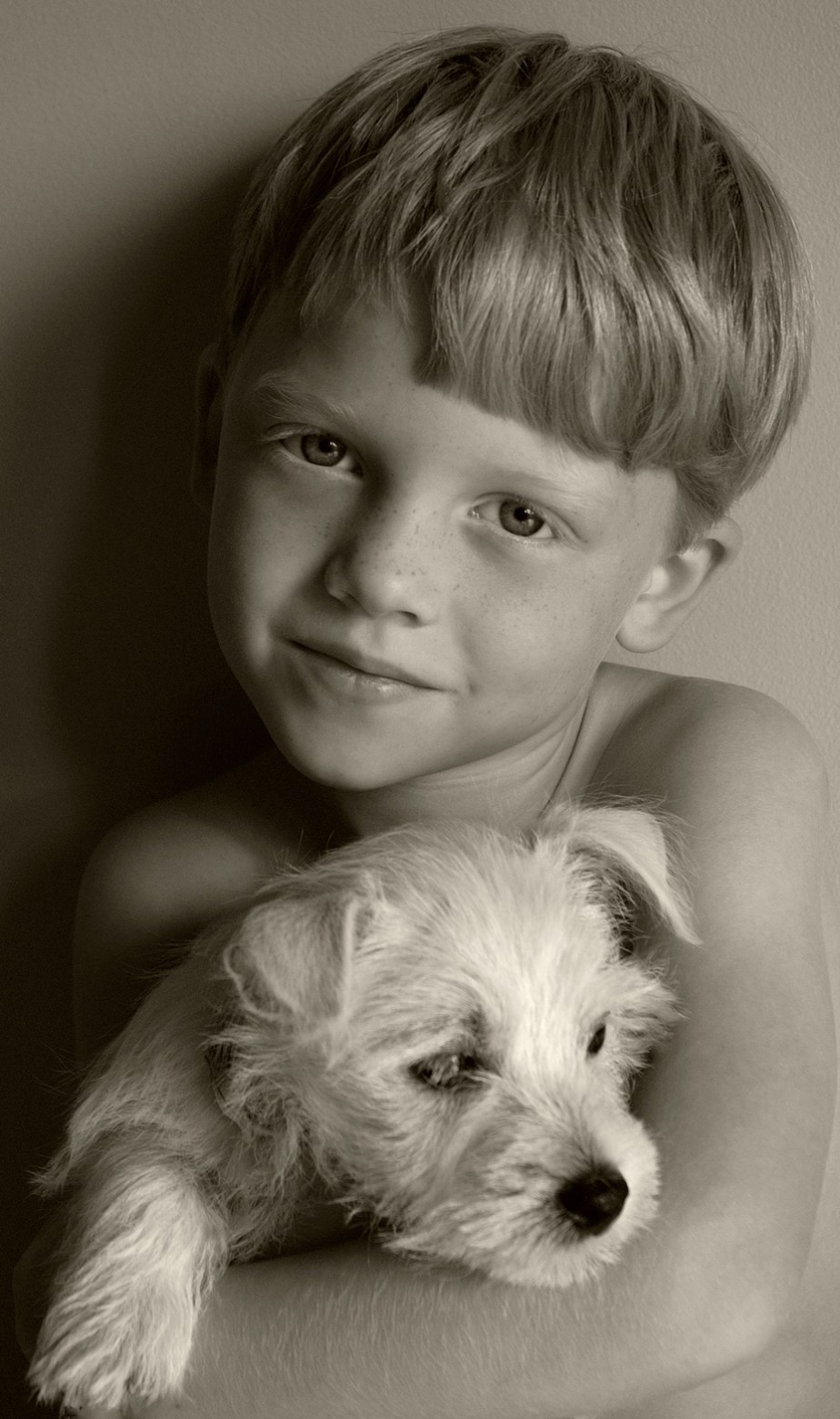
8-16
ABOUT THIS PHOTO A puppy can certainly divert a child’s attention from the business at hand, fortunately. His affection comes through both in expression and gesture. Taken at ISO 200, f/6.3, and 1/160 second. ©Heather Jacks / www.heatherjacksphotography.com
School-age Children
As children grow up and start school they are exposed to more social interaction and, as a result, become more self-conscious. There is something about five- and six-year-olds that makes them ever-ready to pose with the big, cheesy grin with no provocation. You need to really listen and learn about these children, so that you can engage them in conversation or activity that distracts them from themselves.
They are on to the say-cheese tricks of the trade and consider it cooperative to smile broadly no matter what (well trained by some school photographers and well-meaning parents). It then becomes your challenge to distract them from that, as in 8-17 and 8-18, where the family dogs were the perfect solution. One way to do this is to take a photograph of the cheesy grin and let children see the image. Then tell them that they don’t have to do a big smile; they can do a quiet smile and ask them to do it. Take the shot and show them again. Eliciting their help can make your job much easier.
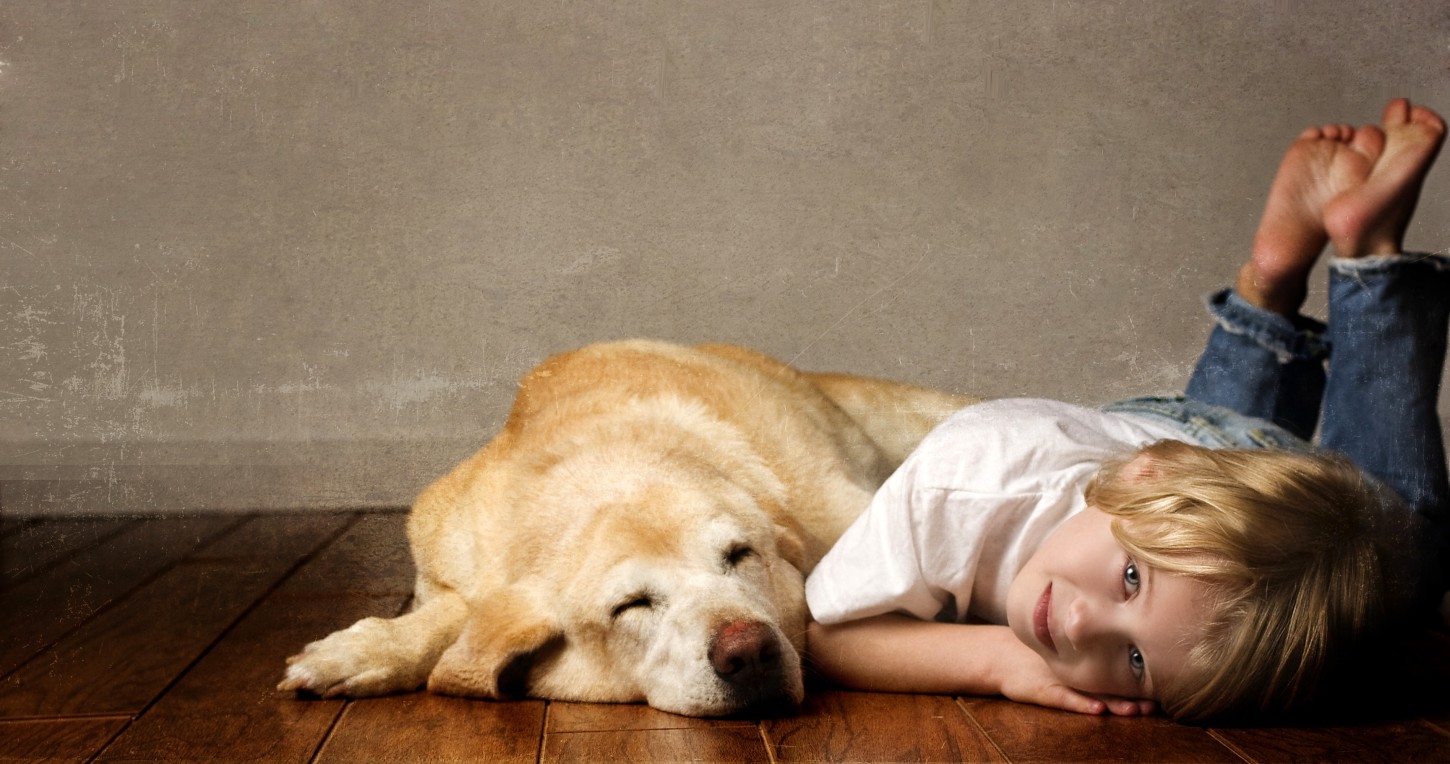
8-17
ABOUT THIS PHOTO Nothing warms the hearts of children more than their dog, and this image shows a natural and tender moment proving just that. Taken at ISO 100, f/5.0, and 1/200 second. ©Angela Hibbert / www.angelahibbertphotography.com
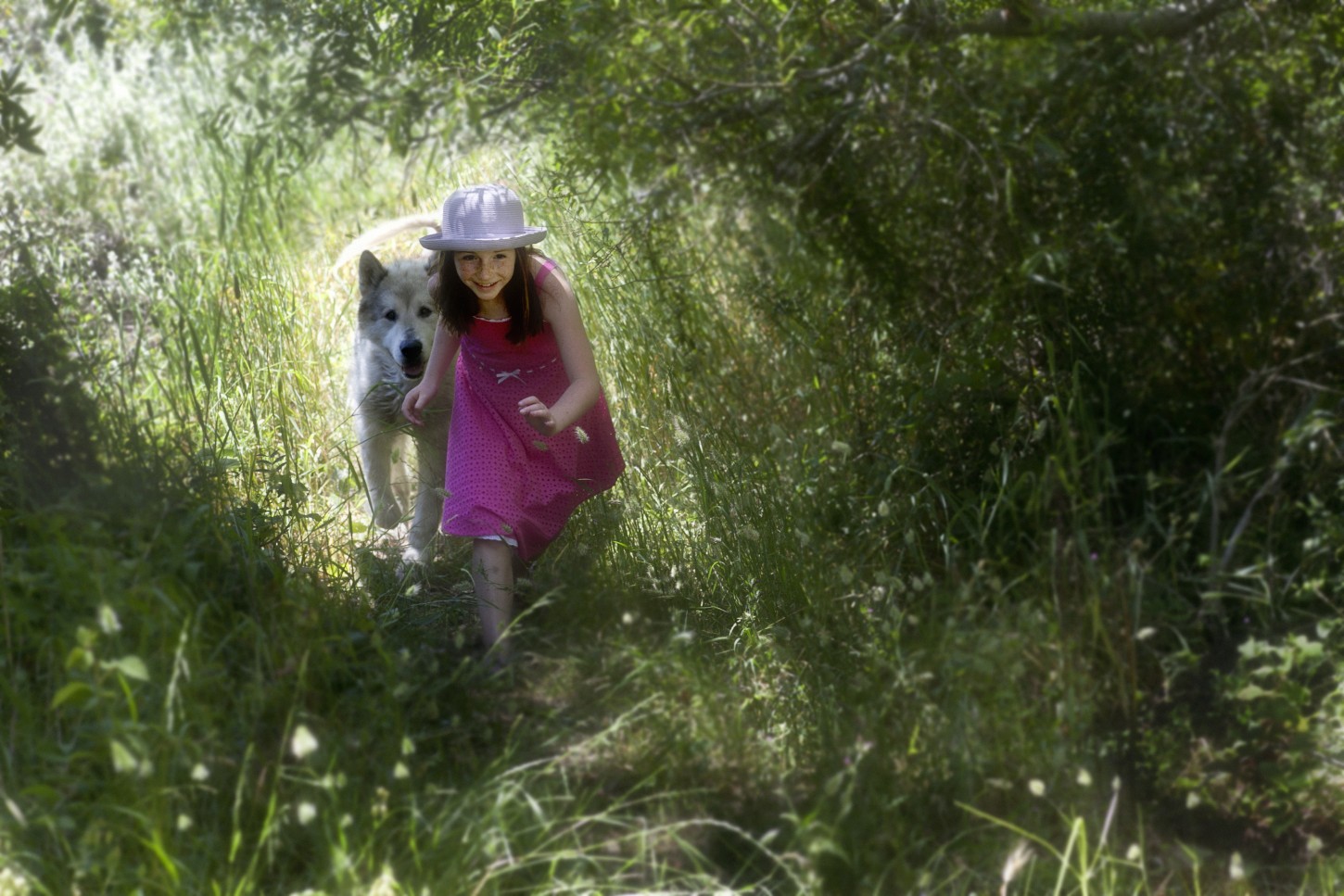
8-18
ABOUT THIS PHOTO Our venture through the woods with her dog gives Daisy the kind of joy that shows in her body language and relaxed, ebullient gesture. The shallow depth of field was created in post-processing using blurring selectively. Taken at ISO 640, f/6.3, and 1/500 second. ©Ginny Felch / www.photographingchildren.com
As they get older, children have developed interests and passions that you can find out about in a sincere conversation.
Most of the difficulties that arise with overly cheesy kids are when parents are present. Children know their parents’ buttons and push every one of them if they can. It is natural for parents to want their kids to look good, to not make those funny faces that Uncle Harry makes, to sit up straight, and so on. The tension this can add is palpable. Diffuse the situation by letting the parents know ahead of time what you expect from the photo session; that you don’t expect the kids to be perfect and that, while you are photographing them, you are in charge.
“A sister is a little bit of childhood that can never be lost.” ~Marion C. Garretty
Children of just about any age tire of the whole process, no matter how interesting you make it, within a relatively short period of time. Take advantage of these precious moments and work as quickly as you can. Depending on the age of the children, this magical time can last from 10 minutes to 45 minutes at the most. Let this be a warning, particularly if you are being hired to get the job done.
Get to Know Your Kids Again
Sometimes, taking photographs of other people’s children is easier than taking photographs of your own. In fact, almost always. But maybe that’s because it is easier to get frustrated with your own kids when you are trying to get them to cooperate for photos. While you might wheedle and cajole your neighbor’s kids into doing what you want, you expect your own to hurry up and get with it! Try to step back and pretend like you’re getting to know your kids for the first time. The results may be photographs that are timeless in quality.
Tweens and Teens
Adolescents, also known as tweens and teens, at their best, can be respectful and involved and, at their worst, sulky and disinterested. They are least likely to buy in to any hype and appreciate a more straightforward approach. Many teens want to look cool, and it will behoove you to figure out what cool is for them. Their parents might differ in their opinions, however. It is up to you as a photographer to make it work.
In some way, you must invite teens into the process, whether it is subtle or direct. Involving them in the photography discussion is a good possibility, giving them the respect they would like to have and making them feel they have a choice in the matter.
Some of the most beautiful and profound images can come from a quiet photography session with an adolescent child whose trust you have earned. Notice the eyes and the serious facial expressions of the young man in 8-19 and the girls in 8-20. Some day, they will look back on this photograph and probably remember how they felt at that age and, maybe, what they were thinking at the time the images were captured.
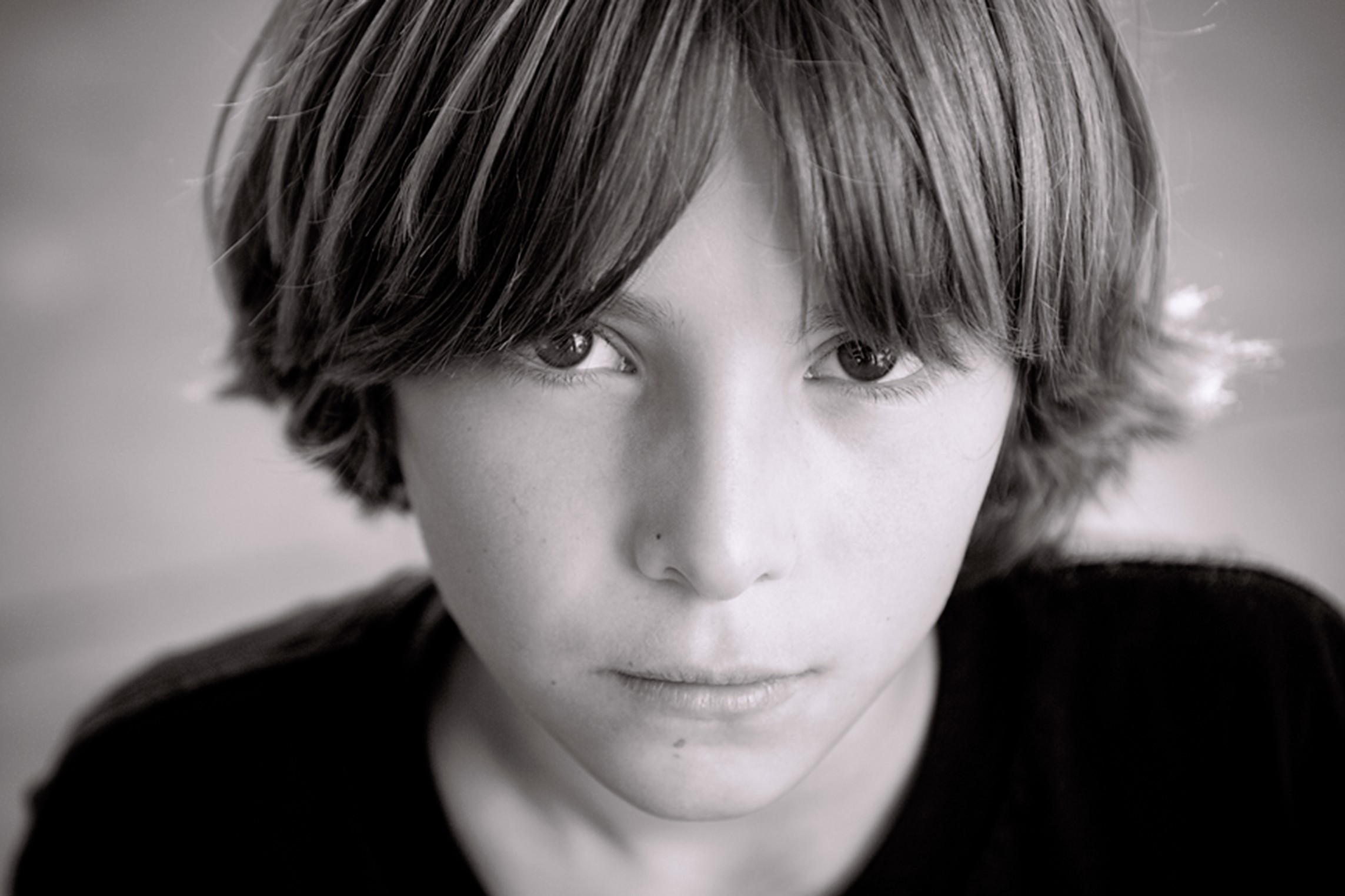
8-19
ABOUT THIS PHOTO This is a direct, captivating close-up of an adolescent boy that makes you want to look deeply into his eyes. Taken at ISO 100, f/2.8, and 1/250 second. ©Matthew Reoch / www.mattreoch.com
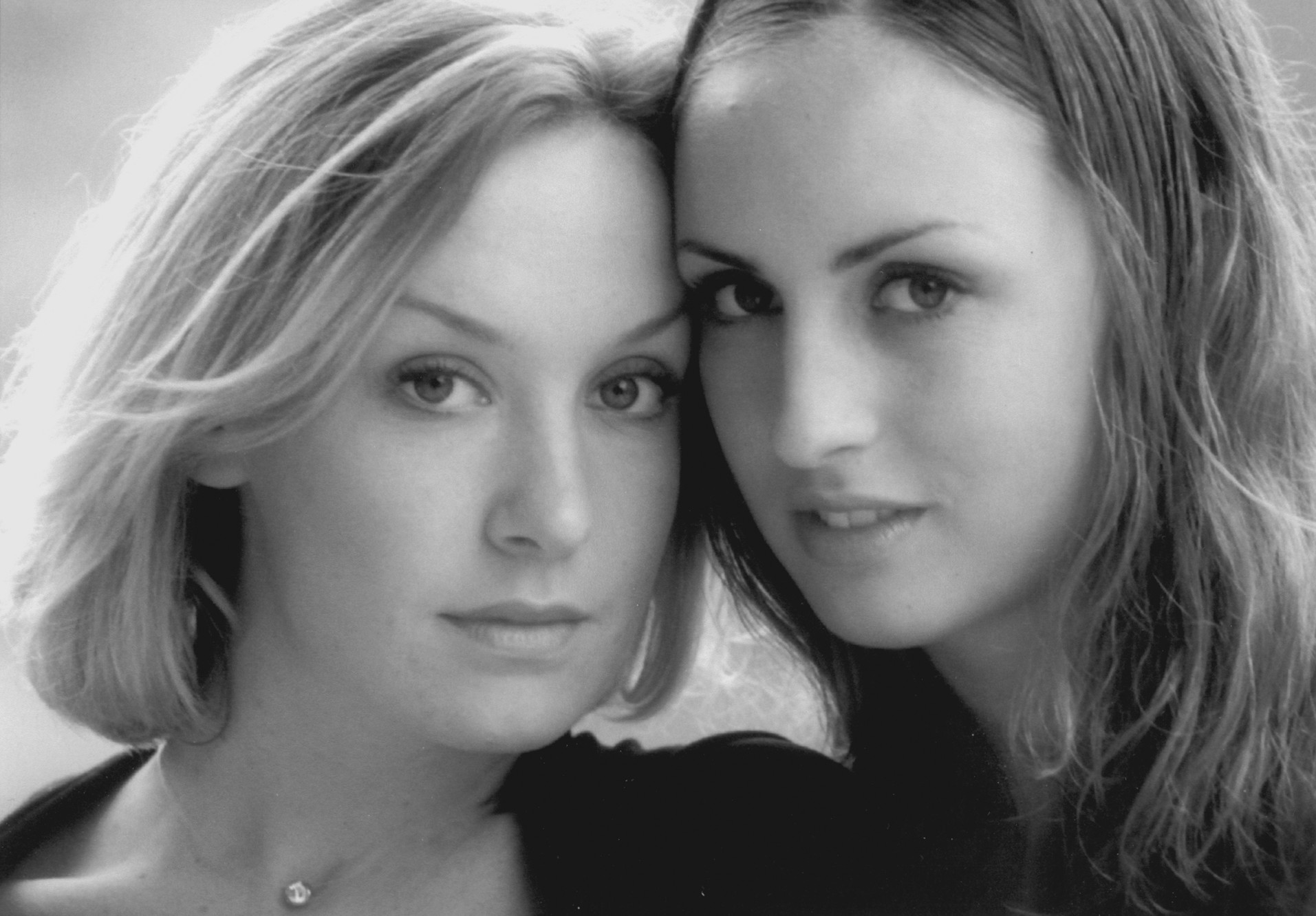
8-20
ABOUT THIS PHOTO This glamorous shot of two teenage sisters is bold yet soft, just as the girls are. Taken at ISO 400, f/4, and 1/125 second. ©Ginny Felch / www.photographingchildren.com
In the meantime, you will have captured very meaningful portraits. These photos portray children on the cusp; they are still children, but there is an older, wiser look in their eyes.
“Family faces are magic mirrors. Looking at people who belong to us, we see the past, present, and future.” ~Gail Lumet Buckley
When I arrived to photograph these young teenaged sisters in their home, they were scurrying around, trying new makeup, fixing their hair, and excitedly throwing around clothing.
Had I been in a hurry to get this done, I would have been frustrated, because I thought they would be ready when I arrived.
For tips on how to change the look of your photographs after they have been captured, turn to Chapter 10.
Instead, I decided to reawaken the teenager in myself and jump right into the preparations and excitement. The drama and playfulness added great energy to the day, and by the time they were photographed, as shown in 8-20, I had earned their trust and respect. We had great fun as well!
The theme here is that all human beings want to be respected and honored. When children are little, you might be able to get away with tricks and treats for a while, but basically, you really need to relate authentically to your subjects in order to produce natural and illustrative photographs.
Often photos taken of tweens and teens commemorate a milestone — graduations, first dances, rites of passage, and so on, as in the photograph in 8-21. The clothing choice, setting, and lighting make it a timeless portrait.
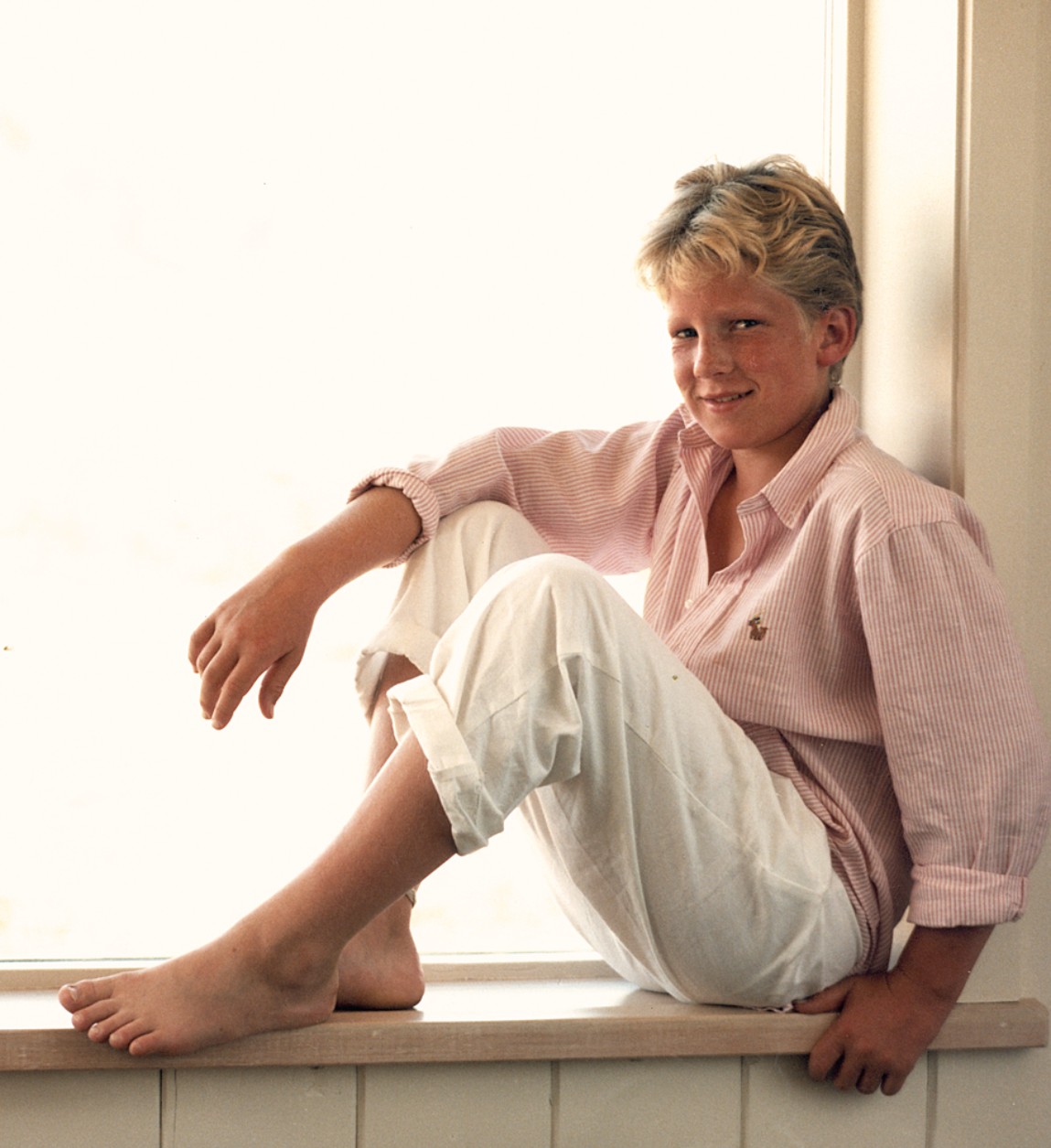
8-21
ABOUT THIS PHOTO My son, Zach after sixth-grade graduation, looked so mellow and laid back at the beach in his new clothes. The bright, clean background and the L-shape of the window of our beach house framed him beautifully. Taken at ISO 200, f/5.6, and 1/125 second. ©Ginny Felch / www.photographingchildren.com
If you are photographing two or more pre-teens together, as in 8-22 and 8-23, the mood will probably be quite different (more energetic and fun) than when you’re photographing them by themselves. Adolescence can be an awkward time for children, so the more fun you can elicit, the more expressive and contemporary your images will turn out.
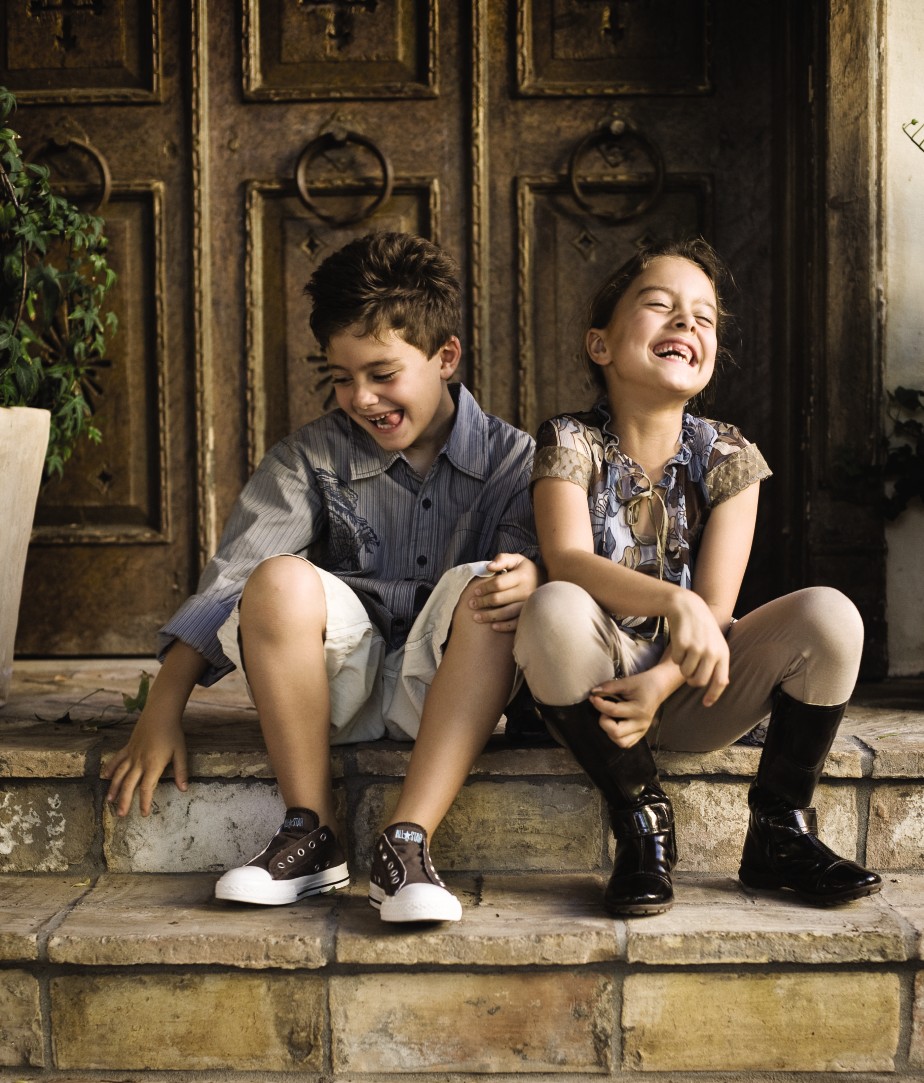
8-22
ABOUT THIS PHOTO Two casual and engaged siblings in a doorway entrance are being really silly and having fun, something that certainly can’t be forced at these ages! Taken at ISO 200, f/2.8, and 1/100 second. ©Allison Tyler Jones / www.atjphoto.com
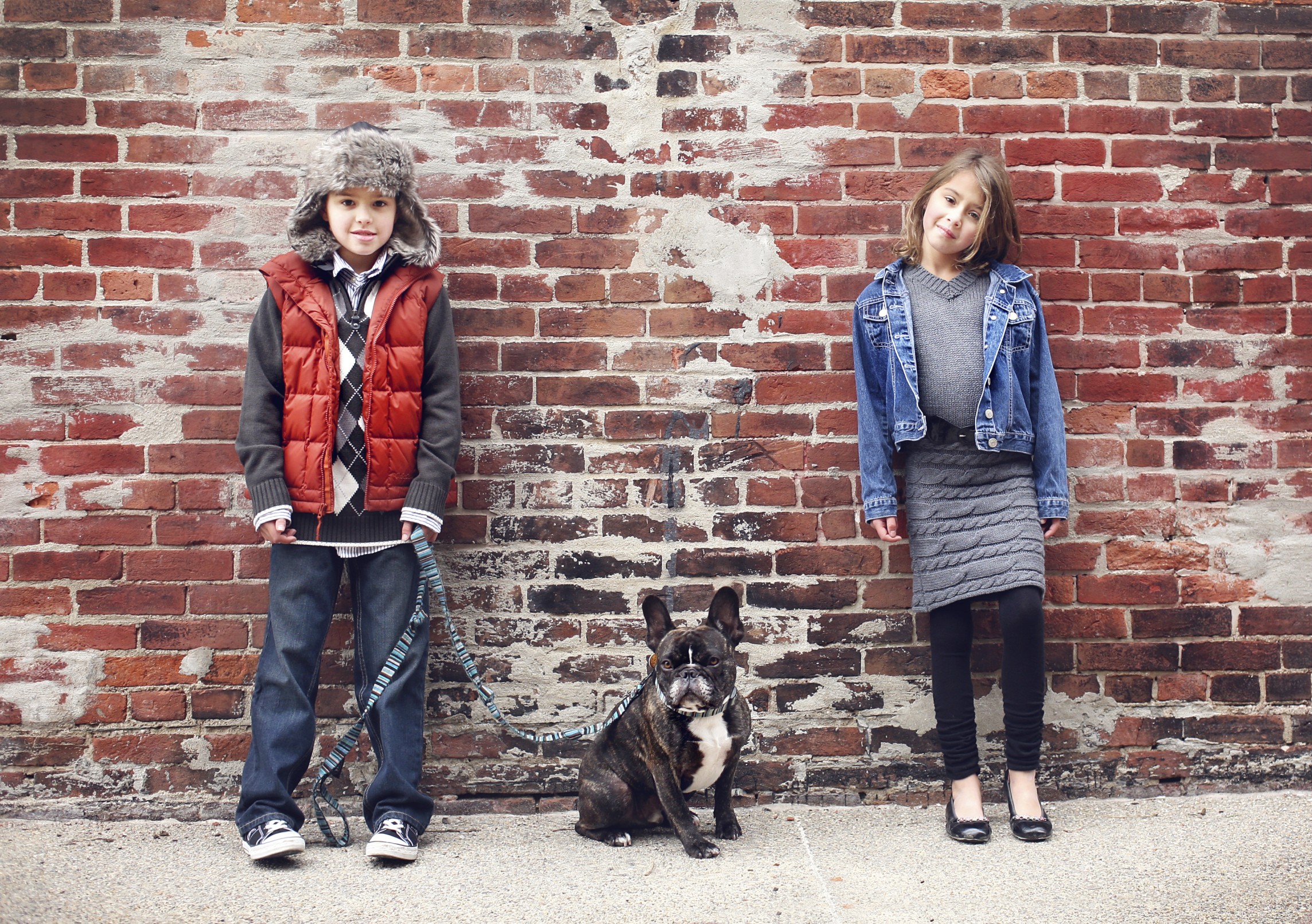
8-23
ABOUT THIS PHOTO Allowing or encouraging teens or tweens to wear their own style of clothes feeds in to their security. This urban background and the inclusion of their dog contribute to the contemporary style. Taken at ISO 400, f/4.0, and 1/160 second. ©Jen Sherrick Photography / www.jensherrickphotography.com
Teen boys
Teen boys can be challenging to photograph. They usually have two modes: smiley or tough, with no in-between. They usually have to be bribed by a parent to get their photograph taken in the first place so your job is to make it as painless as possible for them. It’s helpful to fire off a few shots, even if you know they aren’t exactly what you are looking for, and give him a few, “That’s great, looking good” comments to put him at ease. If he feels successful early on, he’ll relax more quickly. The smiles come more easily and you get a natural expression, as shown in 8-24.
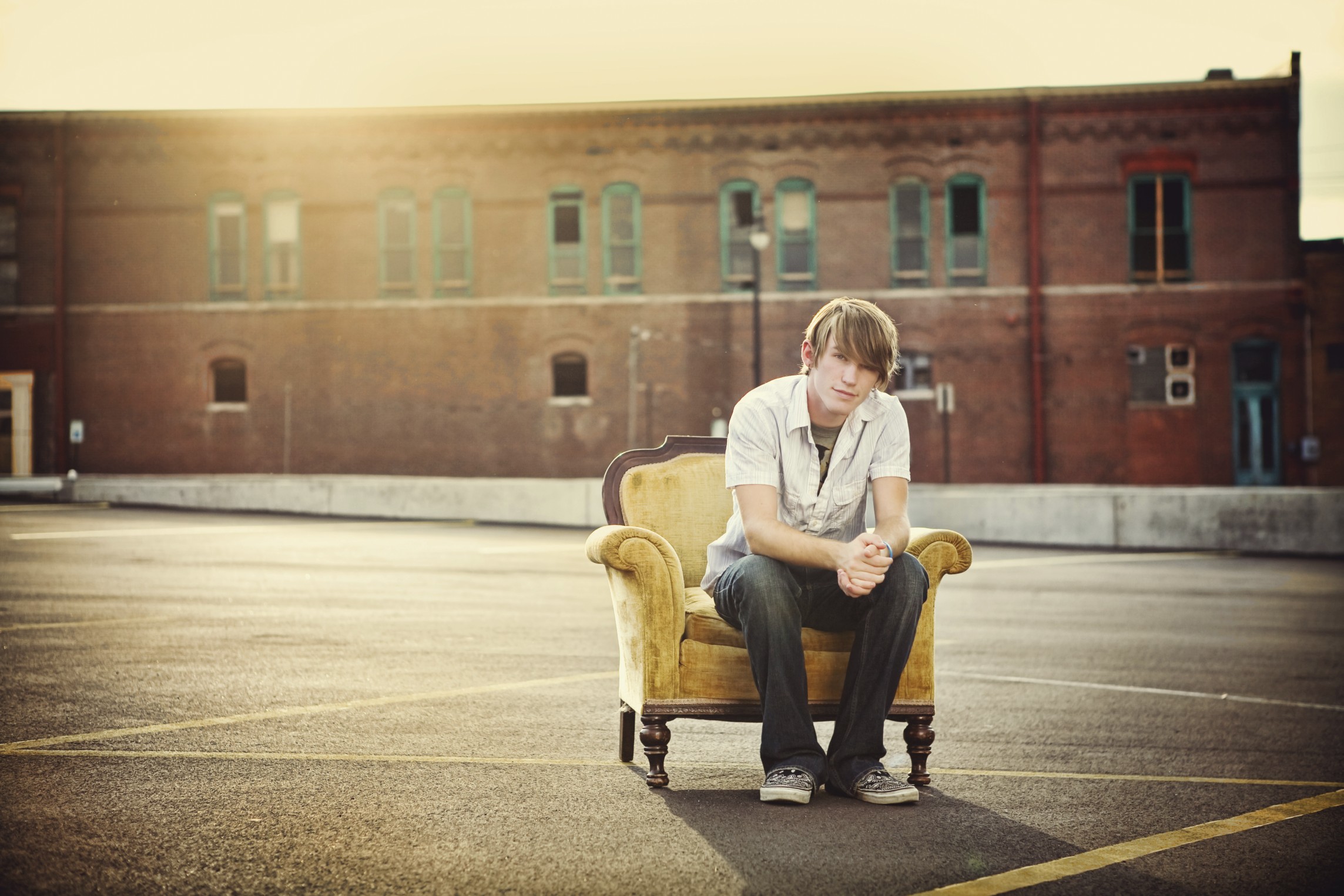
8-24
ABOUT THIS PHOTO Very contemporary and atmospheric, and making use of a familiar building, this portrait is strong, straightforward, and natural. The photographer did post-processing with her own actions. Taken at ISO 100, f/2.8, and 1/640 second. ©Leah Profancik / www.leahprofancik.com
Teen girls
While teen boys are reluctant to be photographed, most teen girls are ready to be the next supermodel. They love to change outfits, try different poses, and will do just about anything you suggest to get the shot. Show them some of the shots you are taking as you go along to show them what is working and what isn’t. Complimenting her on how she looks and how she’s doing will keep confidence high and the energy flowing, as in 8-25.
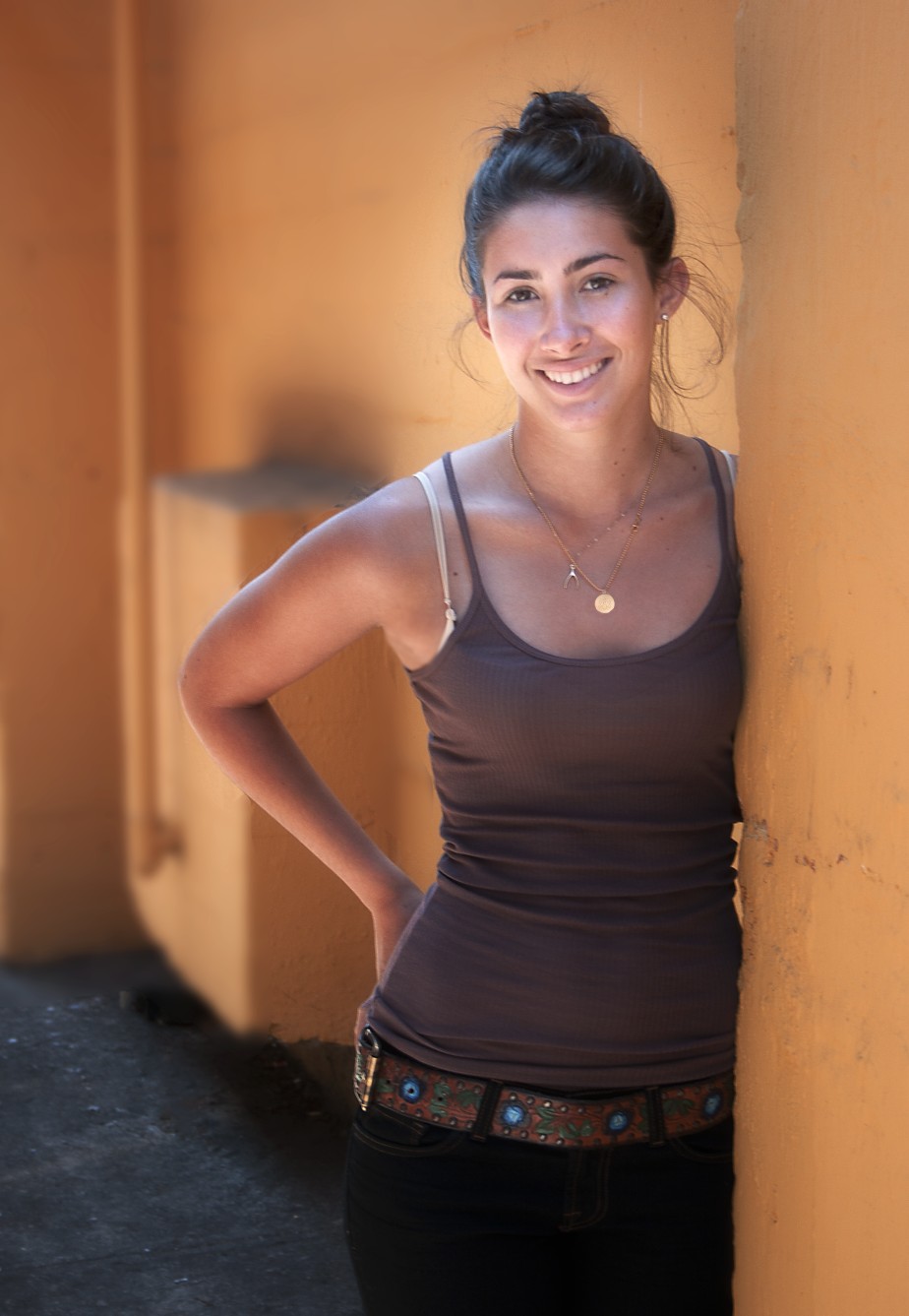
8-25
ABOUT THIS PHOTO This teenage girl was already confident, but even so I gave her positive feedback during the session, evoking a natural and beautiful expression. Taken at ISO 200, f/6.3, and 1/60 second. ©Ginny Felch / www.photographingchildren.com
Grouping Families
As you photograph children’s relationships with parents and siblings, keep in mind that the opportunities to tell a story in your images are waiting for you at every turn. The story can be about connection, either with each other, their environment, or activities.
Parent and child
When you photograph families, spend some time photographing individual relationships within the family — that is, siblings, father/son, mother/daughter, and so on. This is extremely rewarding because there is usually special bonding and tenderness that comes to the surface when you are sensitive and encouraging.
For more on using leading lines like diagonals in your photography, see Chapter 5.
Sometimes an initial awkwardness disappears when you say something like, “Okay, guys, I want to see some serious snuggling!” The barriers come down, and you start to see some genuine connection going on before your eyes. It’s almost as though they are waiting for your permission. That is when your heart beats fast and you are able to capture moments that will be treasured for generations.
When life gets frenetic and stressful, and the world news is depressing, fragile and profound moments, such as the one shown in 8-26, are very uplifting.
“Call it a clan, call it a network, call it a tribe, call it a family. Whatever you call it, whoever you are, you need one.” ~Jane Howard
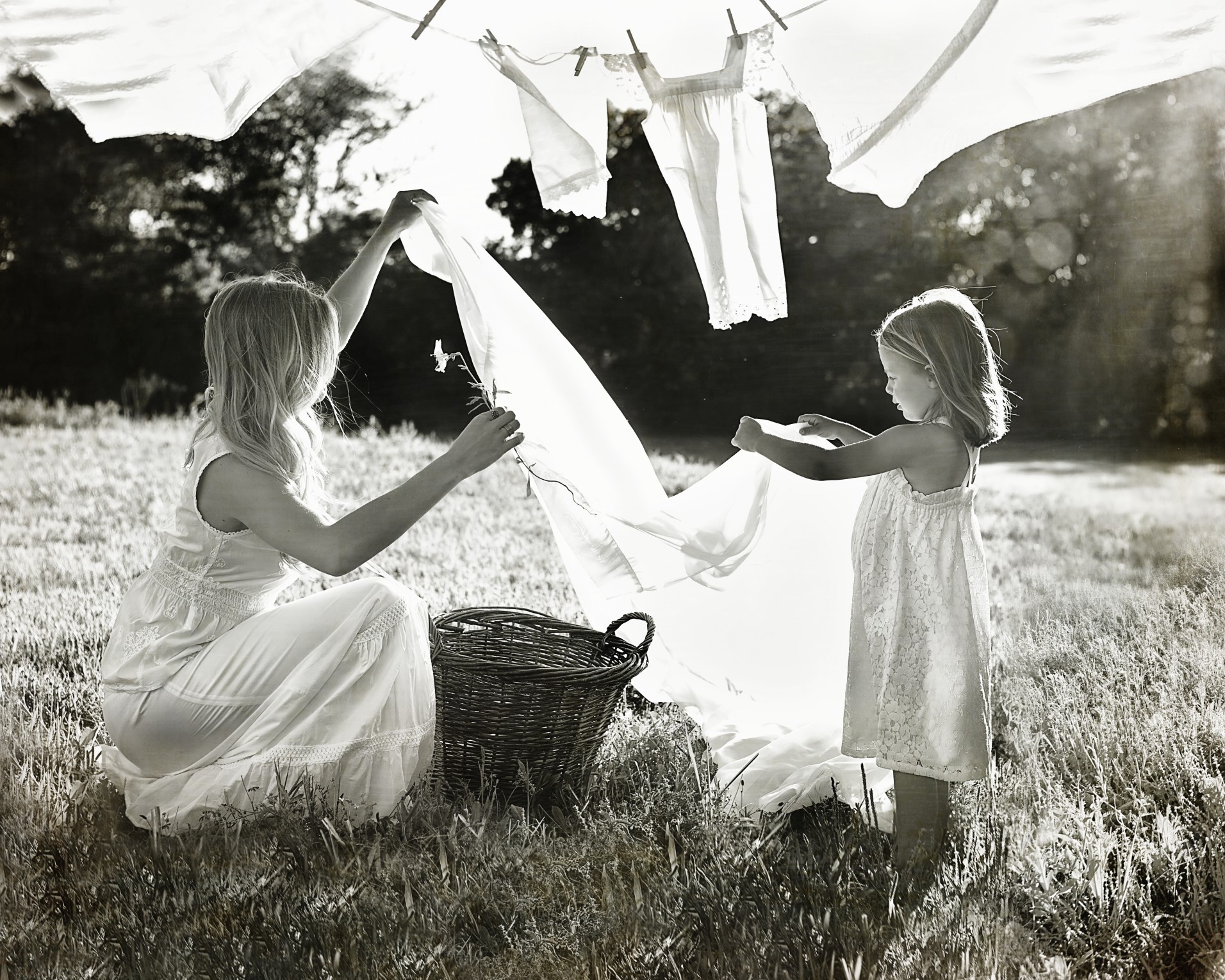
8-26
ABOUT THIS PHOTO Evoking memories and nostalgia, the photographer set up a motherly scene, using late afternoon back lighting to make the sheets glow and give haloes to the subjects. The composition and gestures enhance the sense of connection. Taken at ISO 200, f/5.0, and 1/400 second. ©Mary Shannen / www.melangephoto.com
Don’t rule out dads in terms of eliciting emotional connection. For example, in 8-27 the photographer captured Dad in a seriously tender snuggle, and the blissful feelings of this special moment. The father was not afraid to show his emotions, and that was captured forever.
If you want to evoke a connection between people, you must relate to it yourself and let it mirror back ... from your eyes, via your heart, and back out through the lens!

8-27
ABOUT THIS PHOTO Playtime can be an opportune moment for some extra snuggles, as seen in this peaceful and tender image of a father and his young son. The father’s arms provide a circular composition that wraps up the story. Taken at ISO 400, f/2.2, and 1/100. ©Rachel Owens / www.rachelowensphotography.com
“The family is one of nature’s masterpieces.” ~George Santayana, photographer
Another dad and his daughter roughhouse in 8-28, this simple studio portrait of a connection worth capturing. Placing them in the studio where the background is simple and the light is predetermined offers a freedom for expression and spontaneity.
Move in close for a tight shot of a mother and child, as in 8-29. The expressions here say it all.
Siblings
If it is energy you are seeking when working with children, siblings generate it in abundance. It seems that their personalities bounce off of one another, which can be fun to witness and capture.
Sibling relationships are primal and authentic, for better or worse. If there is tension, and there usually is, it shows. If you can be there to provide some incentive for fun, competition, or yes, even physical connection, your images will shine.

8-28
ABOUT THIS PHOTO A contemporary studio portrait of a father and his wiggly toddler in a silly moment is amusing and tender all at the same time. Taken at ISO 200, f/10, and 1/200 second. ©Allison Tyler Jones / www.atjphoto.com
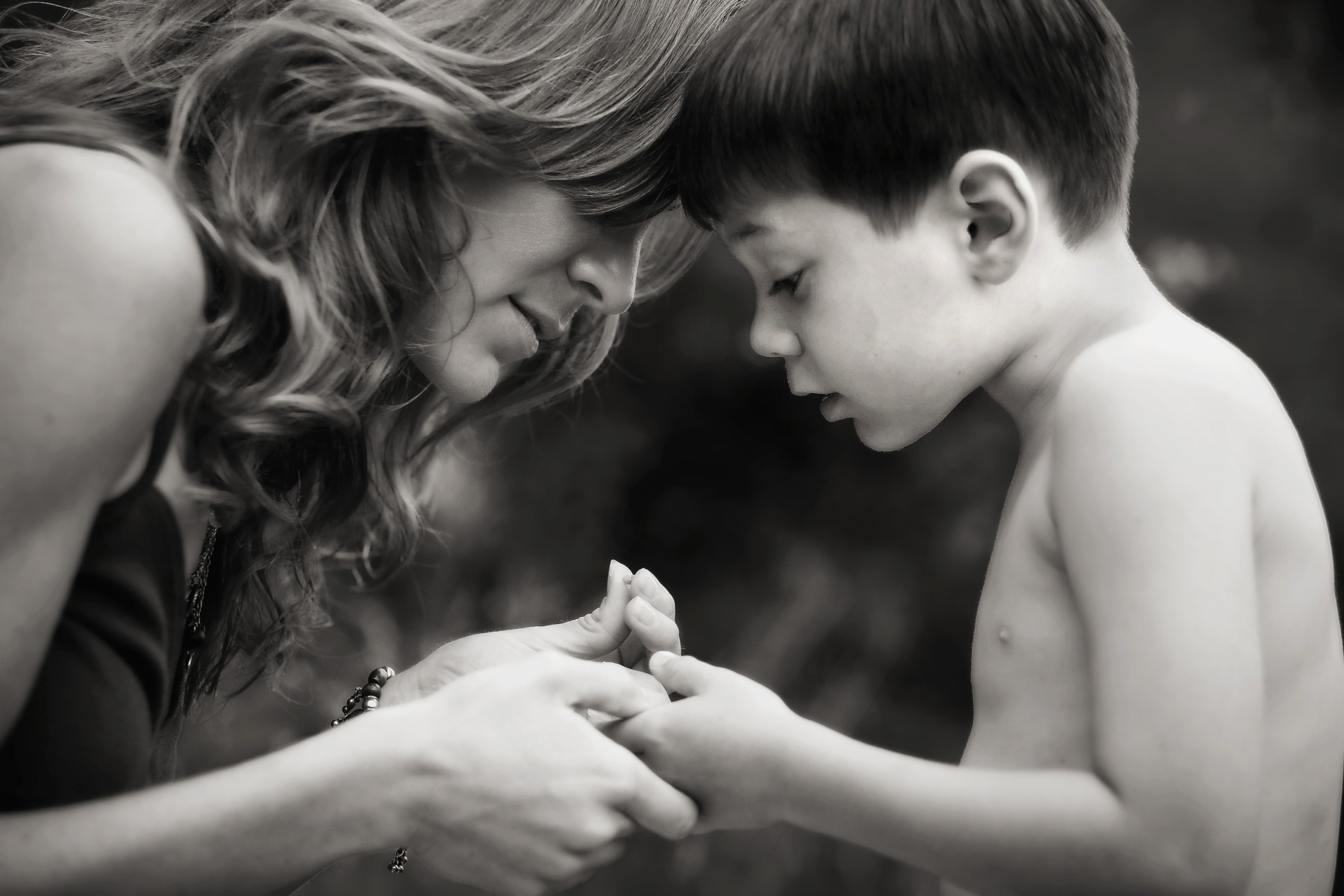
8-29
ABOUT THIS PHOTO The love and connection is obvious between this young boy and his attentive mother. Moving in close puts the focus on the relationship. Taken at ISO 400, f/2.8, and 1/250 second. ©Marianne Drenthe / www.marmaladephotography.com
Often the relationship reveals itself immediately without anything but your observation. It might not show through in conversation, but perhaps in body language, as in 8-30. Be on the lookout.
Don’t enter into the session with preconceived notions and stereotypes such as boys will be boys or girls will be girls. Stay open to the possibility that your expectations can be blown right out of the water. Don’t miss out on opportunities to surprise yourself and entertain the eye of the viewer.
Photographing siblings is a great opportunity to make a storytelling photograph, while the children are interacting with each other or the environment. Try to have them engaged in the same thing, even if it is the photographer, so that there is a semblance of unity, as in 8-31 and 8-32.
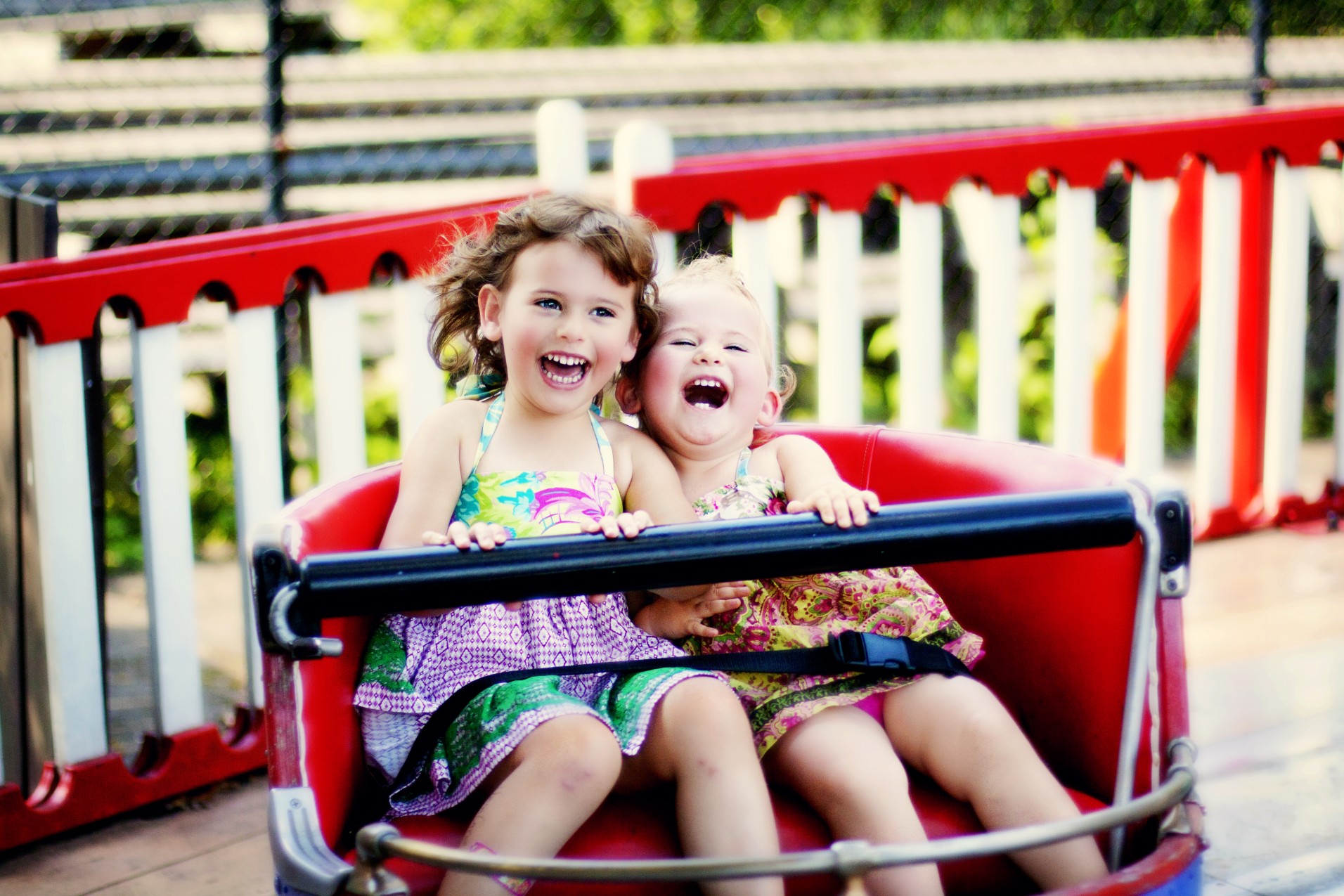
8-30
ABOUT THIS PHOTO Exhilaration and joy, pure and simple, come through in this photograph of sisters at an amusement park, and the bright colors accentuate the story. The shallow depth of field helps calm down the busy background. Taken at ISO 400, f/1.4, and 1/4000 second. ©Jen Carver / www.jencarverphotography.com
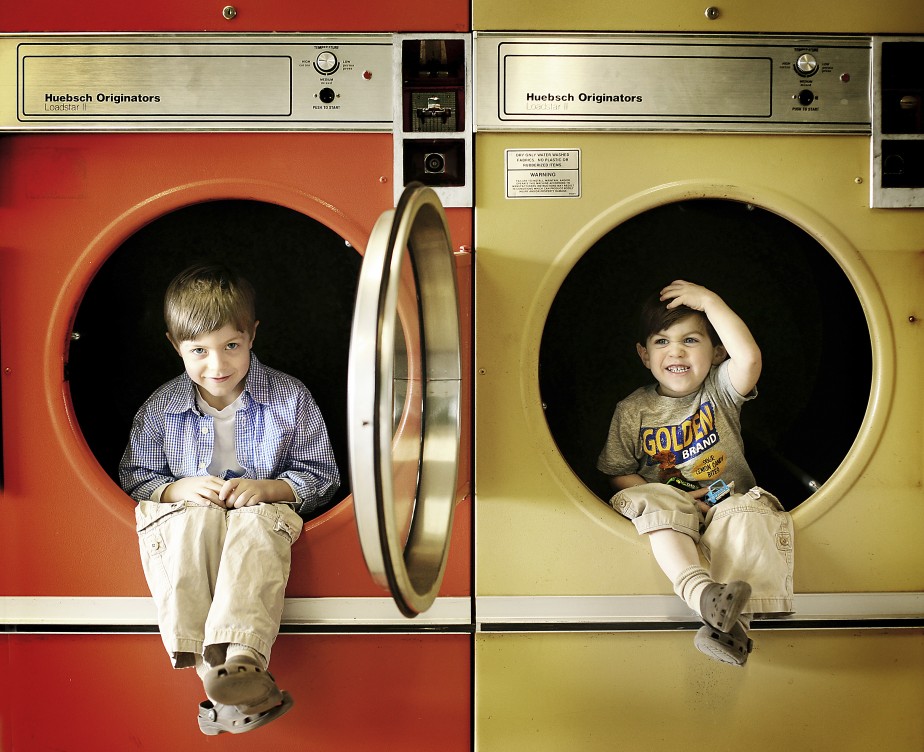
8-31
ABOUT THIS PHOTO Using the large and colorful industrial washing machines as a unique background gave these brothers a chance to be playful and engaged. Taken at ISO 800, f/2.5, and 1/125 second. ©Jen Sherrick / www.jensherrickphotography.com
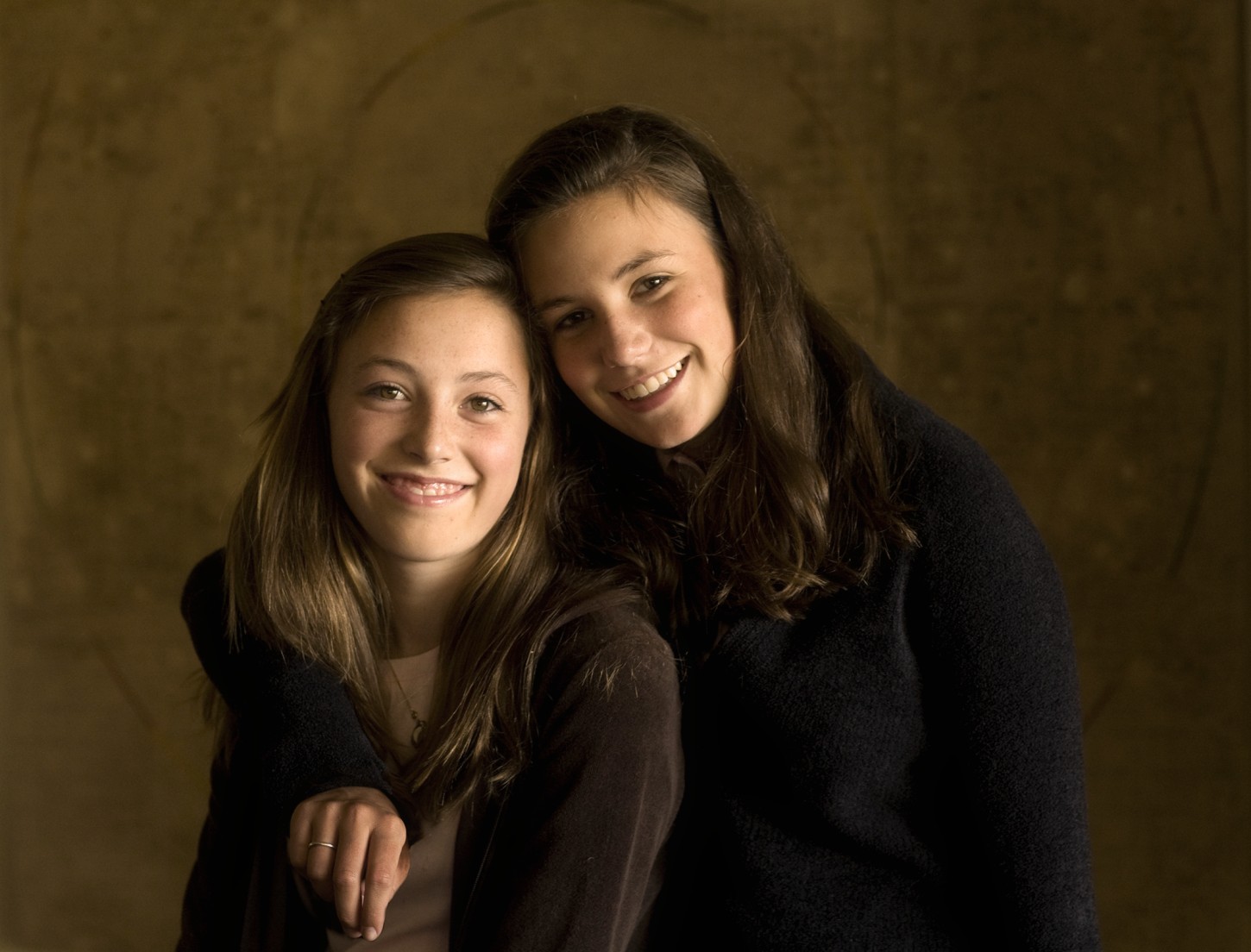
8-32
ABOUT THIS PHOTO These teens are close enough in age that they have a tender relationship, and I brought them together in front of a modern painting in their home as a warm and textured background. I like the familiarity of the background for future referral and nostalgia. Available window light helped create the soft, warm skin tones. Taken at ISO 1600, f/4.5, and 1/60 second. Ginny Felch / www.photographingchildren.com
You can photograph siblings telling secrets, exploring nature as in 8-33, playing together as in 8-34, sharing pets, and so on. Always be prepared for spontaneous eruptions that can occur, no matter what you plan — some might work well for your photograph. A fit of laughter or surprise can tell a lot about siblings together and make a memorable photograph. Don’t feel as though you must direct everything; let them discover some of these on their own.
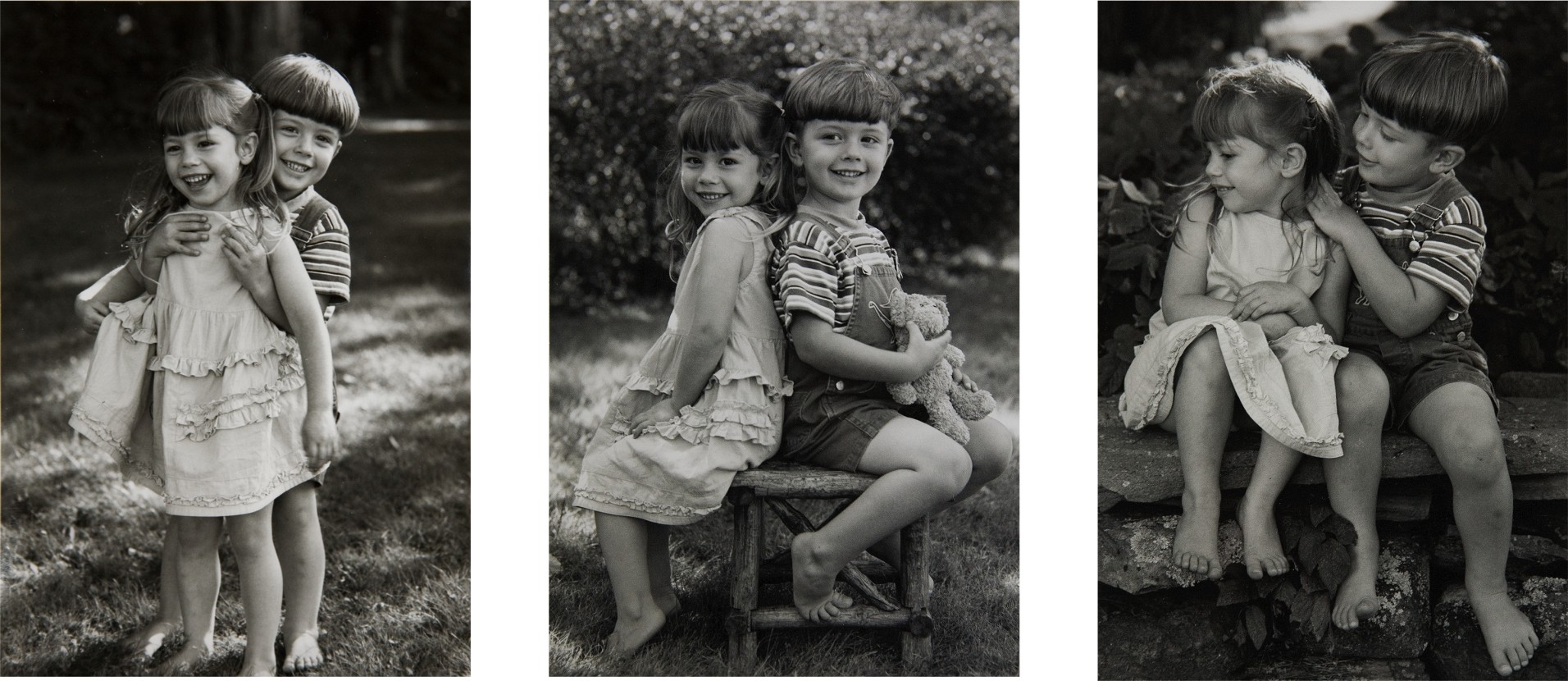
8-33
ABOUT THESE PHOTOS This classic and enchanting series of siblings reveals many facets of their personalities and relationship. The dappled light of the garden and the classic outfits create illustrative portraits. Taken at ISO 320, f/5.6, and 1/125 second. ©Patrisha McLean / www.patrishamclean.com
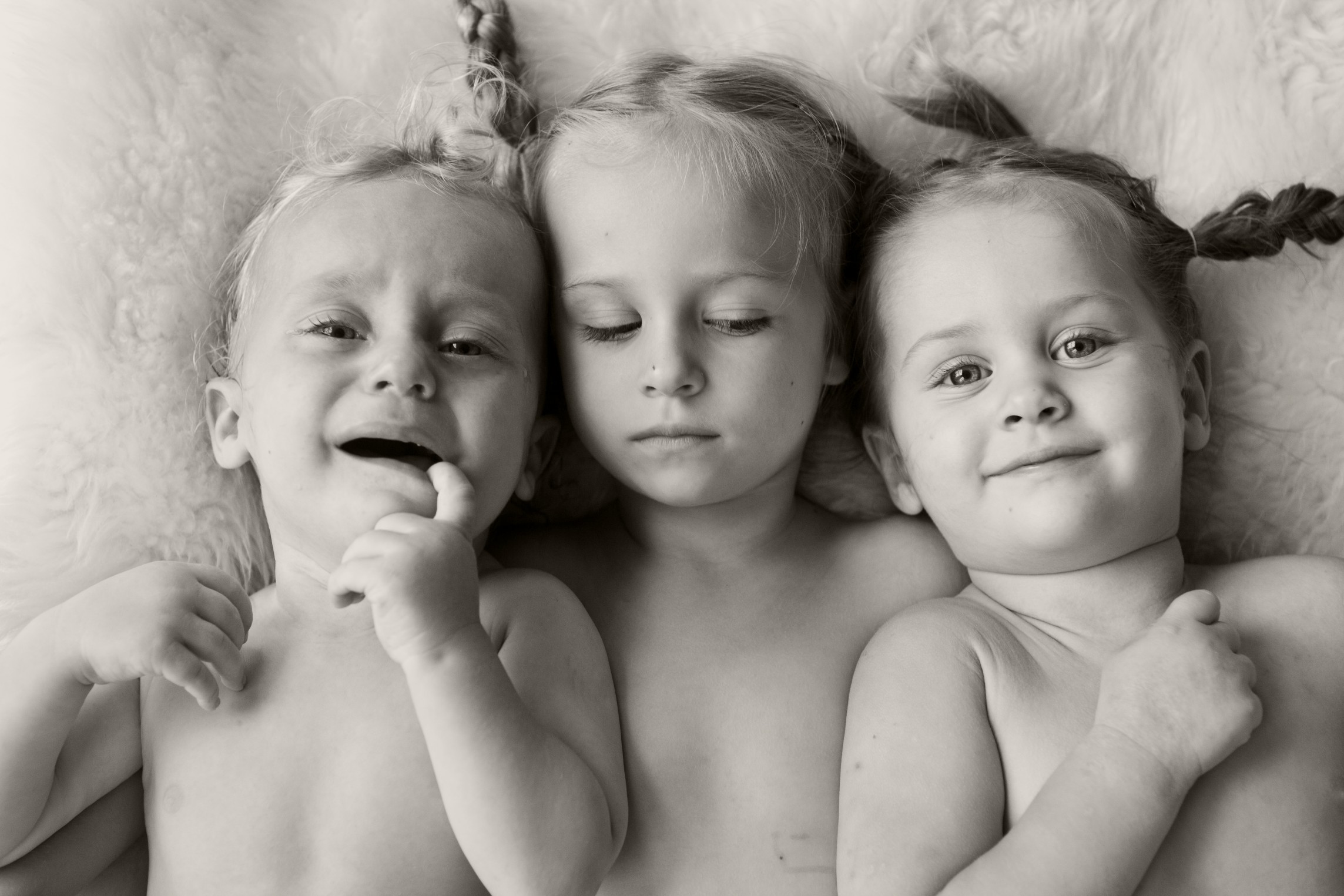
8-34
ABOUT THIS PHOTO Two sisters and their baby brother playing on the bed created an opportunity for the mom to capture an intimate and expressive moment for her memories. The high-key approach emphasized the lovely skin tones. Taken at ISO 400, f/4.0, and 1/50 second. ©Natalija Brunner / www.daidalorange.com
Endless stories can be told in photographing siblings; you are limited only by your imagination!
Families
Photographing families can be as complicated and unique as each individual member. It takes a bit of patience and a lot of psychology, but if you try to make it fun, you’ll have a better chance of success.
Depending on the number of family members, it can be difficult to find a location that accommodates everyone graciously. It is also difficult to avoid the cliché of just having family members sit or stand and smile for the camera. The challenge becomes how to photograph a family creatively.
If you have the luxury of knowing the family or of spending some time with them before the portrait, you are at an advantage. If they have particular interests, such as fishing, picnicking, walking on the beach, and so on, you can plan accordingly. Also, you can learn a little about the personalities, relationships, and so on.
It’s a good idea to take different kinds of photographs during the session so that the family has some choices. If you are going to photograph family members in a straightforward way (facing you, smiling, and so on), you might also encourage them to interact with one another.
Most families today prefer a family portrait that is more than just a visual representation of the family together. They want a family portrait that tells a story about their relationship with each other. For 8-35, a portrait of a mom and dad and their two daughters, I encouraged them to walk along the tide line. I asked them to line up parallel to each other so that they would all be in focus. Then I told them to try to forget about me as they interacted with each other.
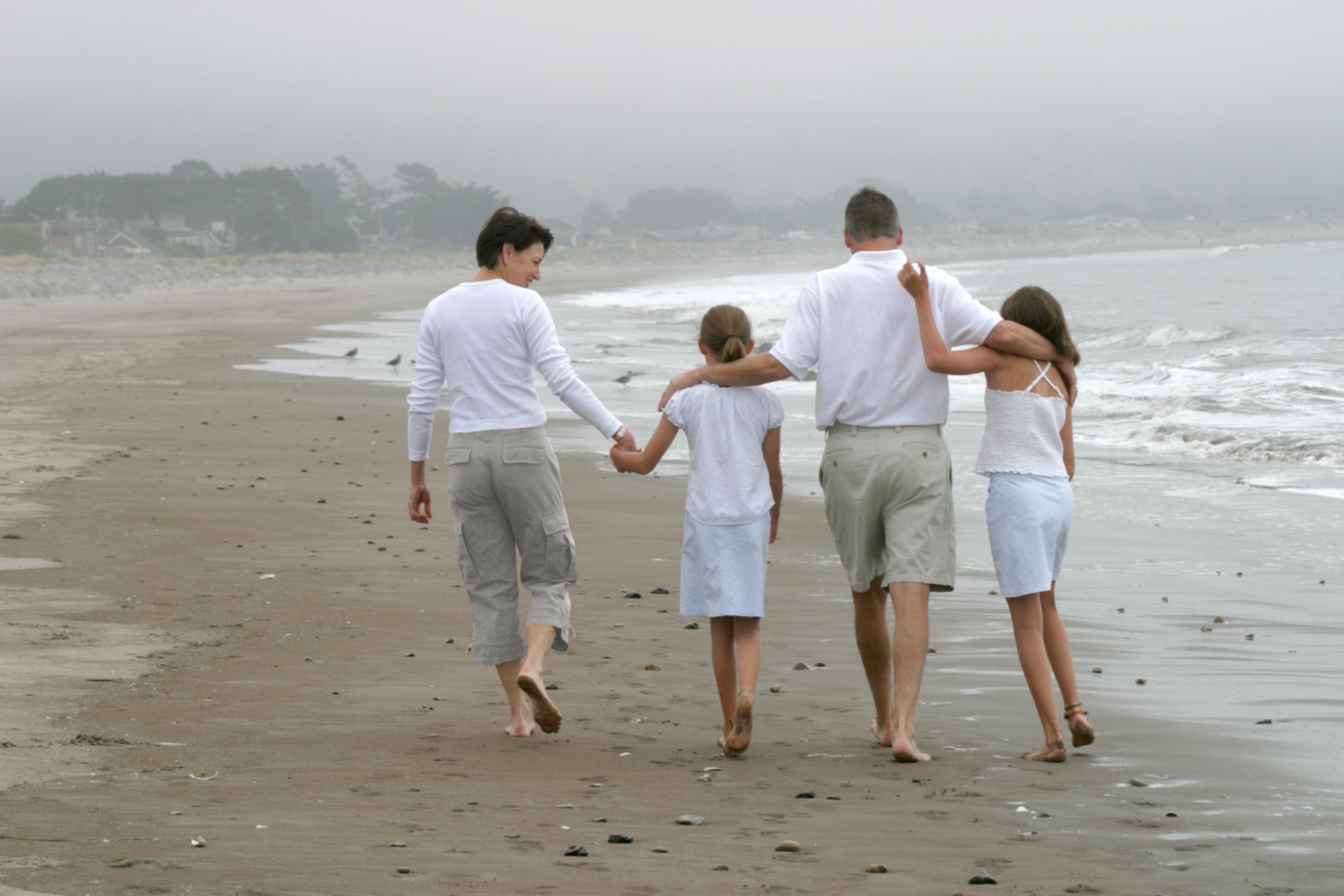
8-35
ABOUT THIS PHOTO The color harmony between the setting and the clothing tie it all together, and the curved path of the shoreline leads you forward. Taken at ISO 400, f/8.0, and 1/125 second. ©Ginny Felch / www.photographingchildren.com
Once the family started walking, I ran up the beach, and using a telephoto lens, followed them coming and going. The result is a photograph with a feeling of lightness and the elegance of a dance. These were not awkward, preadolescent girls, but if they had been, it still would have worked very well.
Modern families are less likely to want their photographs to be serious or posed; they often opt for more natural and candid images. That was the concept by the photographer of the family shown in 8-36 with three small children. The popsicles provided a perfect distraction to keep everyone in one place for a few minutes!
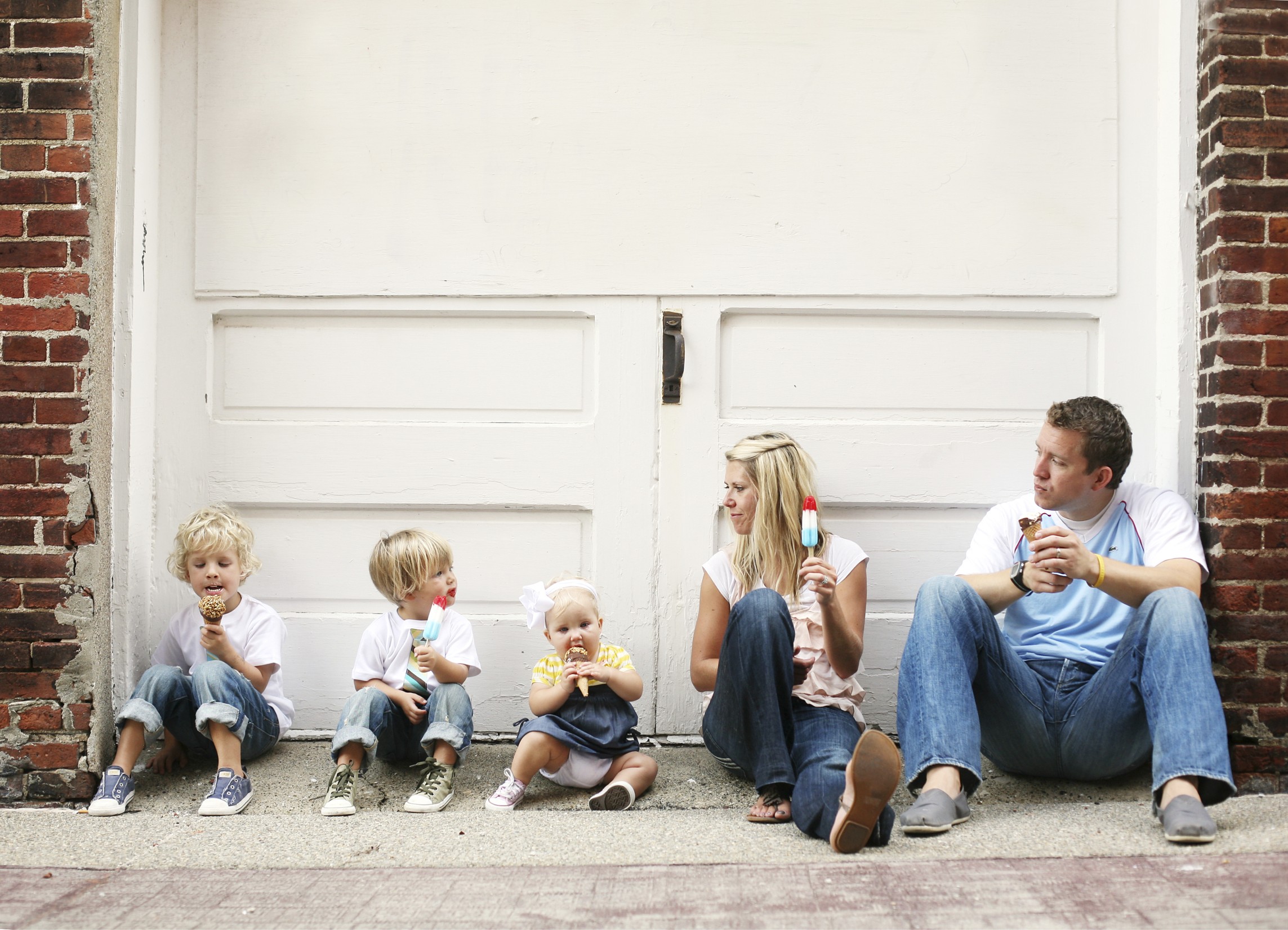
8-36
ABOUT THIS PHOTO The urban setting provided a graphic and textured frame for a playful family moment in this lifestyle portrait. Taken at ISO 400, f/3.2, and 1/640 second. ©Jen Sherrick / www.jensherrickphotography.com
This kind of photograph forces you to move out of a comfort zone if you are used to posing families. However, if you roll with it and join in on the fun and energy, you can be successful.
As more and more photographers enter the hobby, clever ideas abound, such as approaching the family from an unusual angle, as in 8-37. Can you imagine trying to be too serious in that environment?
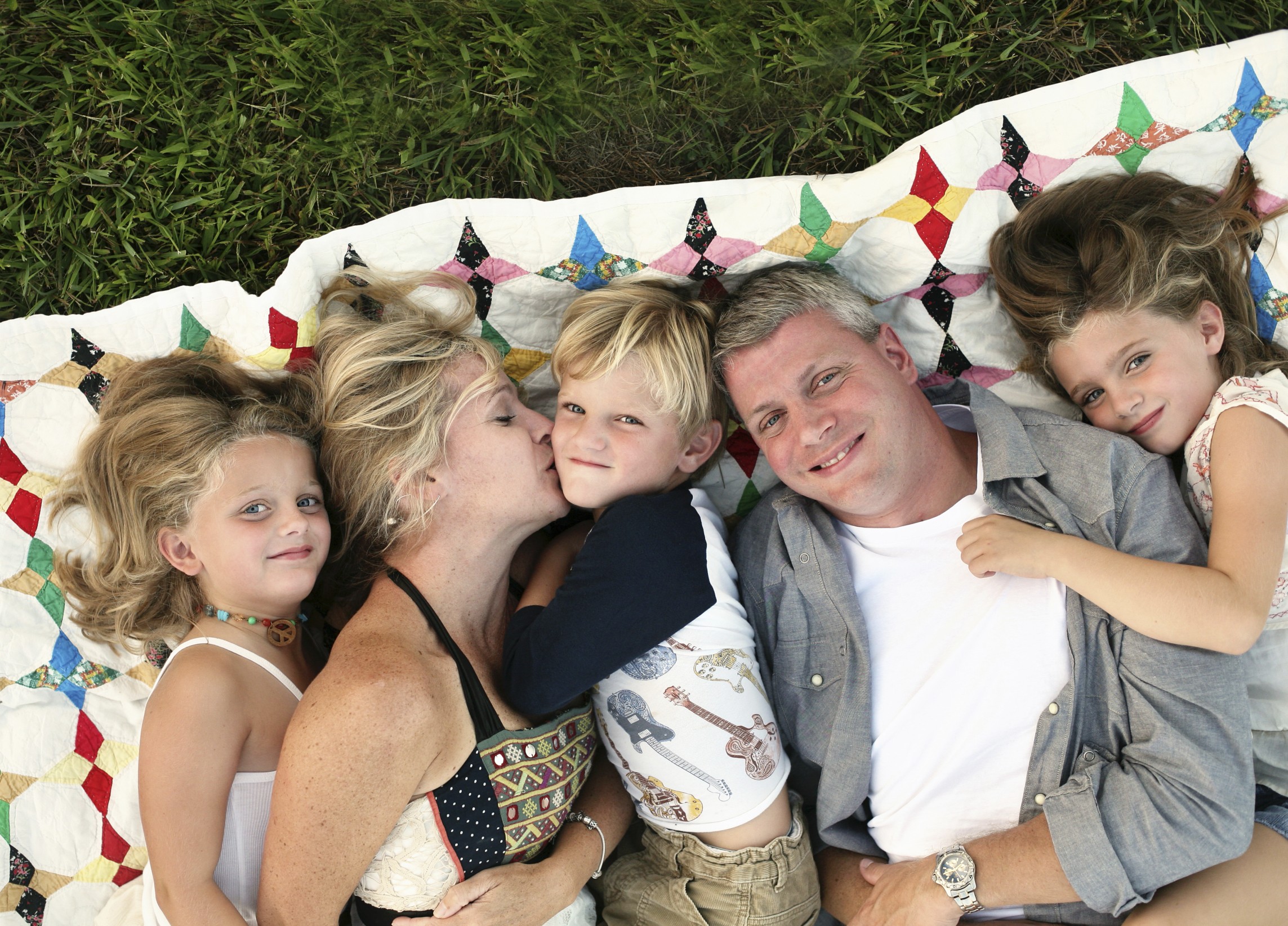
8-37
ABOUT THIS PHOTO As a family poses on a quilt outdoors on the grass, the creative and agile photographer figured out a way to photograph from above, eliciting spontaneous behavior and expressions. Taken at ISO 640, f/3.2, and 1/400 second. ©Jen Sherrick / www.jensherrickphotography.com
Photographing families outdoors or in their homes lends itself to informality automatically, as opposed to photographing in a more-structured studio environment. It also enables you to be more creative as you find new places in which to work. An outdoor location gives you more room to roam when photographing larger family groups, as in 8-38.
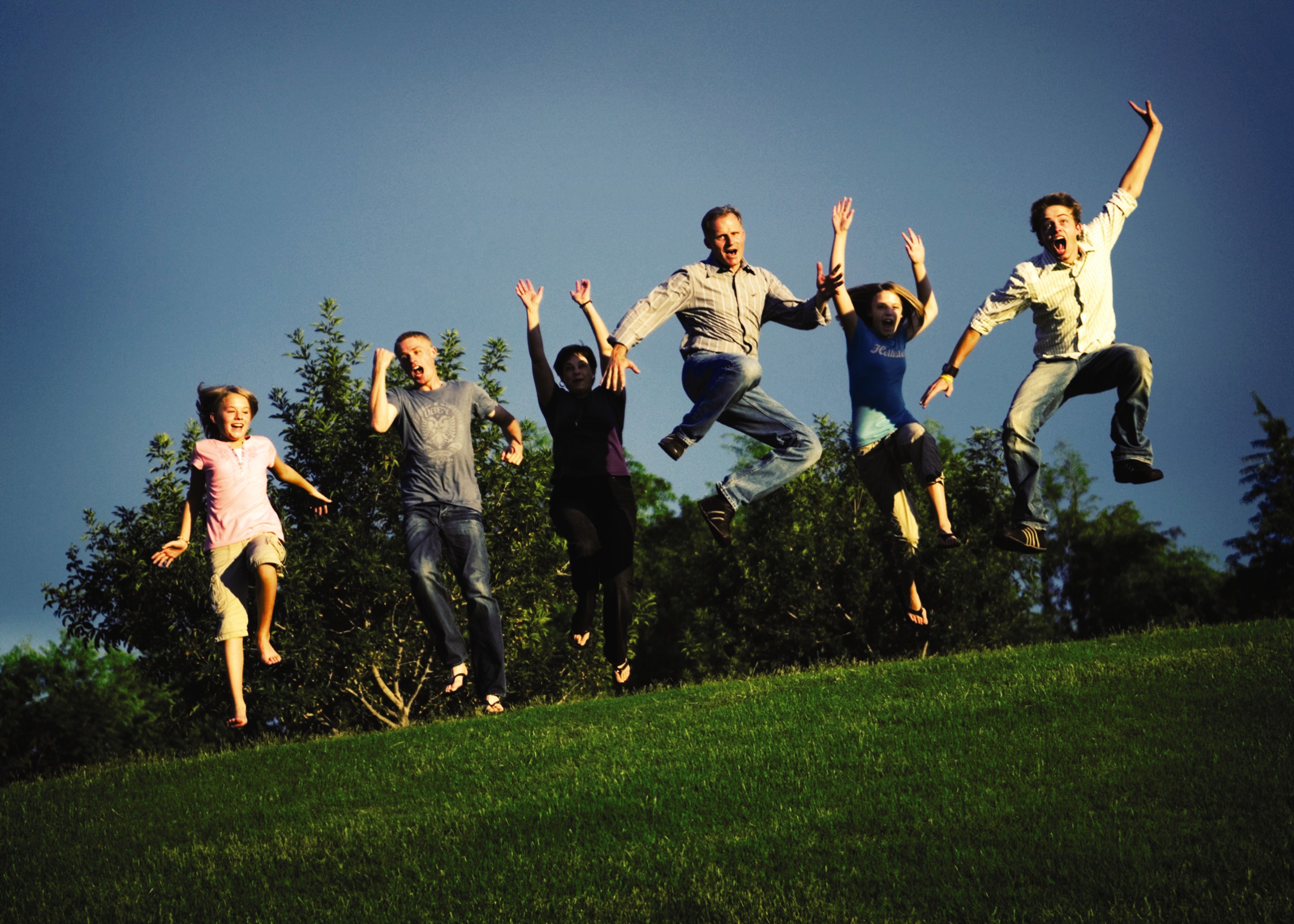
8-38
ABOUT THIS PHOTO This high-energy family portrait captures their fun-loving, active nature. Shooting in a park near their home allowed for a lot of room for running and jumping. Taken at ISO 100, f/2.8, and 1/800 second. ©Allison Tyler Jones / www.atjphoto.com
Assignment
Families and Siblings
Take a photo of a family or siblings together. How are you grouping them to tell a story? Is the photo candid or posed? You can utilize some of the other elements you have learned — for example, composition and lighting — so that you have a stronger image. However, if you have to compromise, do it with light and composition. What is important here is to unite the subjects in one way or another, making a strong statement about the relationship.
In this photograph of a family, the goal was to capture a feeling, something more than just their likenesses. Babies of this age and stage are most often in the arms of their parents, and this image chronicles a very special time in a contemporary style. The beautiful, soft window lighting added to the tender mood. Taken at ISO 200, f/5, and 1/250 second.
Remember to visit www.pwsbooks.com after you complete this assignment and share your favorite photo! It’s a community of enthusiastic photographers and a great place to view what other readers have created. You can also post comments, read encouraging suggestions, and get feedback.

©Allison Tyler Jones / www.atjphoto.com

